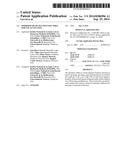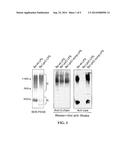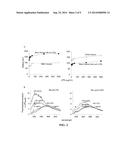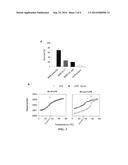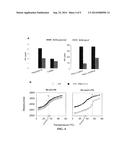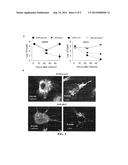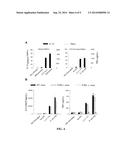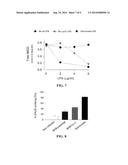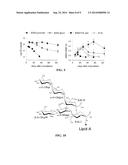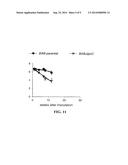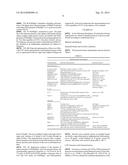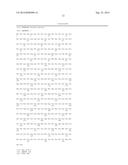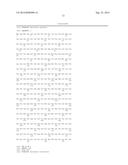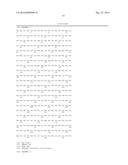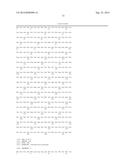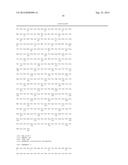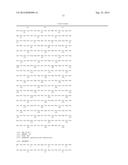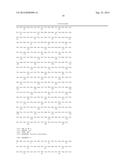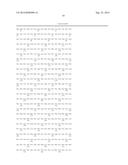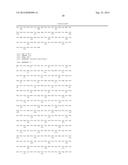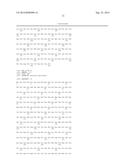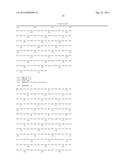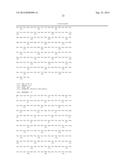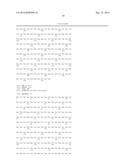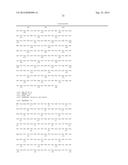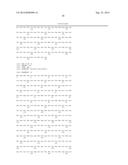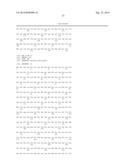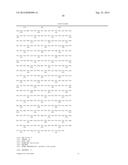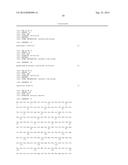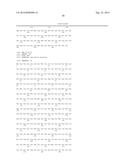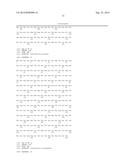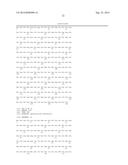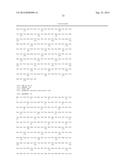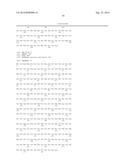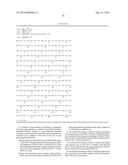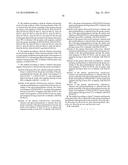Patent application title: Modified Gram-Negative Bacteria For Use As Vaccines
Inventors:
Jean-Pierre Gorvel (Marseille Cedex, FR)
Vilma Arce Gorvel (Marseille Cedex, FR)
Maite Iriarte (Pamplona (navarra), ES)
Ignacio Moriyon (Pamplona (navarra), ES)
Raquel Conde-Alvarez (Pamplona (navarra), ES)
Assignees:
INSTITUT NATIONAL DE LA SANTE ET DE LA RECHERCHE MEDICALE (INSERM)
Centre National De La Recherche Scientifique (CNRS)
UNIVERSITE DE LA MEDITERRANEE AIX-MARSEILLE II
UNIVERSIDAD DE NAVARRA
IPC8 Class: AA61K3939FI
USPC Class:
4242341
Class name: Drug, bio-affecting and body treating compositions antigen, epitope, or other immunospecific immunoeffector (e.g., immunospecific vaccine, immunospecific stimulator of cell-mediated immunity, immunospecific tolerogen, immunospecific immunosuppressor, etc.) bacterium or component thereof or substance produced by said bacterium (e.g., legionella, borrelia, anaplasma, shigella, etc.)
Publication date: 2014-09-25
Patent application number: 20140286996
Abstract:
The invention relates to Gram-negative bacteria carrying an inactivated
gene encoding a glycosyltransferase involved in the synthesis of the core
of the LPS of said Gram-negative bacteria, wherein said inactivated gene
results in the synthesis of a LPS having a modified core. These strains
have an attenuated virulence but induce a humoral immunity sufficient for
ensuring vaccination of the host.Claims:
1. A method for the treatment of brucellosis, comprising the step of
administering to a subject in need thereof a therapeutically effective
amount of a gram-negative bacterium carrying an inactivated gene encoding
a glycosyltransferase involved in the synthesis of the core of the LPS of
said gram-negative bacterium, wherein said glycosyltransferase is
selected from the group consisting of the glycosyltransferases having an
amino acid sequence of SEQ ID NO:1 or SEQ ID NO: 21 and homologues
thereof having an amino acid sequence having at least 50% of identity
with SEQ ID NO: 1 or SEQ ID NO: 21, and wherein said inactivated gene
encoding a glycosyltransferase involved in the synthesis of the core of
the LPS of said Gram-negative bacterium results in the synthesis of a LPS
having a modified core.
2. The method according to claim 1, wherein said amino acid sequence has at least 60% of identity with SEQ ID NO:1 and is selected from the group consisting of SEQ ID NO:2, SEQ ID NO:3, SEQ ID NO:4, SEQ ID NO:5, SEQ ID NO:6, SEQ ID NO:7 and SEQ ID NO:22.
3. The method according to claim 1, wherein said amino acid sequence has at least 50% of identity with SEQ ID NO:21 and is selected from the group consisting of SEQ ID NO:23, SEQ ID NO:24 and SEQ ID NO:25.
4. The method according to claim 1, wherein a gene encoding a protein involved in the synthesis of the O-polysaccharide of the LPS is inactivated.
5. The method according to claim 4, wherein said protein involved in the synthesis of the O-polysaccharide of the LPS is selected from the group consisting of the proteins having the amino acid sequence of SEQ ID NO:8, SEQ ID NO:9, SEQ ID NO:10, SEQ ID NO:11, SEQ ID NO:12, SEQ ID NO:13, SEQ ID NO:14, SEQ ID NO:15, SEQ ID NO:16, SEQ ID NO:26, SEQ ID NO:27 and SEQ ID NO:28 and homologues thereof having an amino acid sequence having at least 50% of identity with an amino acid sequence selected from the group consisting of SEQ ID NO:8, SEQ ID NO:9, SEQ ID NO:10, SEQ ID NO:11, SEQ ID NO:12, SEQ ID NO:13, SEQ ID NO:14, SEQ ID NO:15, SEQ ID NO:16, SEQ ID NO:26, SEQ ID NO:27 and SEQ ID NO:28
6. The method according to claim 4, wherein said protein involved in the synthesis of the O-polysaccharide of the LPS is a perosamine synthetase having the amino acid sequence of SEQ ID NO:13 or a homologue thereof having an amino acid sequence having at least 90% of identity with the amino acid sequence of SEQ ID NO:13.
7. The method according to claim 1, wherein said gram-negative bacterium is selected from the group consisting of bacteria of the genus Brucella, wherein said glycosyltransferase is selected from the group consisting of the glycosyltransferases having: the amino acid sequence of SEQ ID NO: 1 or SEQ ID NO: 21, and homologues thereof having an amino acid sequence having at least 60% of identity with NO: 1 or NO: 21, bacteria of the species Ochrobactrum anthropi, wherein said glycosyltransferase is selected from the group consisting of the glycosyltransferases having: the amino acid sequence of SEQ ID NO:5, an amino acid sequence having at least 85% of identity with SEQ ID NO:1, the amino acid sequence of SEQ ID NO:23 and an amino acid sequence having at least 62% of identity with SEQ ID NO:21, bacteria of the species Ochrobactrum intermedium, wherein said glycosyltransferase is selected from the group consisting of the glycosyltransferases having: the amino acid sequence of SEQ ID NO:6, an amino acid sequence having at least 85% of identity with SEQ ID NO:1, the amino acid sequence of SEQ ID NO:24 and an amino acid sequence having at least 62% of identity with SEQ ID NO:21, bacteria of the species Bartonella henselae, wherein said glycosyltransferase is selected from the group consisting of the glycosyltransferases having: the amino acid sequence of SEQ ID NO:22, and an amino acid sequence having at least 69% of identity with SEQ ID NO:1, bacteria of the species Bartonella quintana, wherein said glycosyltransferase is selected from the group consisting of the glycosyltransferases having: the amino acid sequence of SEQ ID NO:2 and an amino acid sequence having at least 65% of identity with SEQ ID NO:1, bacteria of the species Bartonella tribocorum, wherein said glycosyltransferase is selected from the group consisting of the glycosyltransferases having: the amino acid sequence of SEQ ID NO:3, and an amino acid sequence having at least 64% of identity with SEQ ID NO:1, bacteria of the species Bartonella bacilliformis, wherein said glycosyltransferase is selected from the group consisting of the glycosyltransferases having: the amino acid sequence of SEQ ID NO:4, and an amino acid sequence having at least 61% of identity with SEQ ID NO:1, bacteria of the species Agrobacterium tumefaciens, wherein said glycosyltransferase is selected from the group consisting of the glycosyltransferases having: the amino acid sequence of SEQ ID NO:7 and an amino acid sequence having at least 63% of identity with SEQ ID NO:1, and bacteria of the species Agrobacterium radiobacter, wherein said glycosyltransferase is selected from the group consisting of the glycosyltransferases having: the amino acid sequence of SEQ ID NO:25 and an amino acid sequence having at least 57% of identity with SEQ ID NO:21.
8. The method according to claim 7, wherein said bacteria of the genus Brucella is selected from the group consisting of the bacteria of the species Brucella melitensis, Brucella abortus, Brucella suis, Brucella ovis, Brucella pinnipedialis, Brucella ceti, Brucella microti, and Brucella canis.
9-16. (canceled)
Description:
FIELD OF THE INVENTION
[0001] The invention generally relates to the field of modified gram-negative bacteria for use as vaccines.
BACKGROUND OF THE INVENTION
[0002] Gram-negative bacteria are those bacteria that do not retain crystal violet dye in the Gram staining protocol. Many species of Gram-negative bacteria are pathogenic, meaning that they can cause disease in a host organism. This pathogenic capability is usually associated with certain components of Gram-negative cell walls, in particular the lipopolysaccharide (also known as LPS or endotoxin) layer.
[0003] LPS is a major component of the outer membrane of Gram-negative bacteria, contributing greatly to the structural integrity of the bacteria, and protecting the membrane from certain kinds of chemical attack. LPS also increases the negative charge of the cell membrane and helps stabilize the overall membrane structure. LPS is an endotoxin, and induces a strong response from normal animal immune systems. LPS is additionally an exogenous pyrogen (external fever-inducing compound). LPS comprises three parts: polysaccharide (O) side chains, a core polysaccharide and lipid A.
[0004] Lipid A contains unusual fatty acids (e.g. hydroxy-myristic acid) and is embedded in the outer membrane while the rest of the LPS projects from the surface. Lipid A is a disaccharide with multiple fatty acid tails reaching into the membrane. When bacterial cells are lysed by the immune system, fragments of membrane containing lipid A are released into the circulation, causing fever, diarrhea, and possible fatal endotoxic shock (also called septic shock).
[0005] The polysaccharide side chain is referred to as the O-antigen of the bacteria. O side chain (O-antigen) is a polysaccharide chain that extends from the core polysaccharide. The composition of the O side chain varies between different Gram-negative bacterial strains. O side chains are easily recognized by the antibodies of the host, however, the nature of the chain can easily be modified by Gram-negative bacteria to avoid detection.
[0006] The core oligosaccharide contains unusual sugars (e.g. KDO, keto-deoxyoctulosonate and heptose), but little is known concerning its role. In particular, its role in virulence has never been studied directly.
[0007] Numerous LPS mutants inducing humoral immunity to lipopolysaccharide (LPS) have been proposed as potential vaccines. However, pure LPS mutants or bacteria expressing LPS mutants are generally considered too toxic to be used as vaccines, in particular in view of their strong adverse effects, and there is thus a need for new vaccines, presenting an attenuated virulence and inducing a sufficient humoral immunity for ensuring vaccination of the host.
SUMMARY OF THE INVENTION
[0008] The inventors have found that, by modifying a particular structure of the core of the LPS of Gram-negative bacteria, it is possible to obtain strains having an attenuated virulence but inducing a humoral immunity sufficient for ensuring vaccination of the host. Indeed, the inventors have discovered that particular glycosyltransferases involved in the synthesis of the core of the LPS have a critical role in Gram-negative bacteria virulence. When at least one of these glycosyltransferases is inactivated, the modified LPS synthesized by the Gram-negative bacteria induce a strong immune response of the host and its vaccination. Moreover, the inventors have further shown that the administration to a host of a LPS produced by Gram-negative bacteria wherein at least one of said glycosyltransferases is inactivated induces an unspecific immune response and can thus be used as an adjuvant for stimulating the immune system.
DETAILED DESCRIPTION OF THE INVENTION
[0009] An object of the invention concerns a Gram-negative bacterium carrying an inactivated gene encoding a glycosyltransferase involved in the synthesis of the core of the LPS of said Gram-negative bacterium,
wherein said glycosyltransferase is selected from the group comprising the glycosyltransferases having the amino acid sequence of SEQ ID NO:1 or SEQ ID NO:21, or homologues thereof having an amino acid sequence having at least 50%, particularly at least 60%, more particularly at least 70%, most particularly at least 80% of identity with SEQ ID NO:1 or SEQ ID NO:21, and wherein said inactivated gene encoding a glycosyltransferase involved in the synthesis of the core of the LPS of said Gram-negative bacterium results in the synthesis of a LPS having a modified core.
[0010] The inventors have shown that the glycosyltransferase having the amino acid sequence of SEQ ID NO:1 is a glycosyltransferase involved in the synthesis of a particular branched structure of the core of the LPS of Brucella abortus. This glycosyltransferase has been called BABLpcC by the inventors. In particular, the inventors have shown that, contrary to all mutants of the LPS core described to date which induce the deletion of the core and of the O-chain of the LPS (Gonzales et al.; PLOS one, July 2008, vol. 3, issue 7, e2760), the mutant Gram-negative bacteria according to the invention present a LPS which lacks part of the core but keeps an intact O-chain. These results evidence that Brucella abortus possesses a branched LPS core, which was unknown to date (sec FIG. 10, which gives a proposed structure of the core of the LPS of Brucella abortus). Without wanting to be bound by a theory, it is believed that this branched structure of core of the LPS in the wild type bacteria is important in avoiding recognition by innate immunity. Consequently, the Gram negative bacteria mutants according to the invention trigger a more intense and protective immune response, and thus constitute very promising vaccines.
[0011] In addition to the BABLpcC of Brucella abortus, the inventors have also shown that homologous glycosyltransferases exist in other organisms. As a result, it is highly credible that the particular structure of the core of the LPS of Brucella abortus exists in other organism. The inventors have further shown that these homologous proteins have an amino acid sequence presenting a high percentage of identity with SEQ ID NO:1, of at least 60%, particularly of at least 70%, more particularly of at least 80%.
[0012] Examples of glycosyltransferases involved in the synthesis of the core of the LPS and having a high percentage of identity with BABLpcC are presented in the table hereinafter:
TABLE-US-00001 Organism SEQ ID NO: % identity with SEQ ID NO: 1 Bartonella quintana 2 65 Bartonella tribocorum 3 64 Bartonella bacilliformis 4 61 Ochrobactrum anthropi 5 85 Ochrobactrum intermedium 6 85 Agrobacterium tumefaciens 7 63 Bartonella henselae 22 69
[0013] Hence, in a particular embodiment, the invention also concerns the gram-negative bacterium according to the invention wherein said amino acid sequence having at least 60%, particularly at least 70%, more particularly at least 80% of identity with SEQ ID NO: 1 is selected from the group comprising SEQ ID NO:2, SEQ ID NO:3, SEQ ID NO:4, SEQ ID NO:5, SEQ ID NO:6, SEQ ID NO:7 and SEQ ID NO:22.
[0014] In addition to the glycosyltransferase of SEQ ID NO:1, the inventors have shown that another glycosyltransferase, having the sequence of SEQ ID NO:21, is also involved in the synthesis of the branched structure of the core of the LPS of a Gram-negative bacterium, Brucella abortus. The inventors have also shown that homologous glycosyltransferases exist in other organisms, as previously described for BABLpcC. The inventors have further shown that these homologous proteins have an amino acid sequence presenting a percentage of identity with SEQ ID NO:21 of at least 50%, particularly of at least 60%, more particularly of at least 62%.
[0015] Examples of glycosyltransferases involved in the synthesis of the core of the LPS and having a percentage of identity with SEQ ID NO:21 of at least 50%, particularly of at least 60%, more particularly of at least 62% are presented in the table hereinafter:
TABLE-US-00002 Organism SEQ ID NO: % identity with SEQ ID NO: 21 Ochrobactrum anthropi 23 62 Ochrobactrum intermedium 24 62 Agrobacterium radiobacter 25 57
[0016] In another particular embodiment, the invention also concerns the Gram-negative bacteria according to the invention wherein a gene encoding a protein involved in the synthesis of the O-polysaccharide of the LPS is inactivated. Indeed, in addition to the inactivation of genes encoding glycosyltransferases involved in the synthesis of the branched structure of the core of the LPS, it is of interest to inactivate genes involved in the synthesis of the O-polysaccharide of the LPS. Such a "double mutant", lacking the branched structure of the core and partially or totally lacking the O-chain, is useful for distinguishing animals that are vaccinated with it and animals that are infected with the naturally occurring Gram-negative bacterium (wild type), as explained hereafter in the description.
[0017] Examples of genes encoding a protein involved in the synthesis of the O-polysaccharide of the LPS are wboB, wboA, wbkE, wbkA, gmd, per, wzm, wzt, wbkB, wbkC, wbkF and wbkD (Gonzales et al.; PLOS one, July 2008, vol. 3, issue 7, e2760). Their SEQ IDs are given in the table hereinafter:
TABLE-US-00003 Gene name Predicted protein function Amino acid SEQ ID wboB Mannosyl (perosaminyl) 8 transferase wboA Mannosyl (perosaminyl) 9 transferase wbkE Mannosyl (perosaminyl) 10 transferase wbkA Mannosyl (perosaminyl) 11 transferase gmd GDP-mannose dehydratase 12 per Perosamine synthetase 13 wzm ABC transporter 14 wbkF Undecaprenyl-glycosyltransferase 15 wbkD Epimerase/dehydratase 16 wzt ABC transporter 26 wbkB Synthetase 27 wbkC Formyltransferase 28
[0018] Accordingly, in an embodiment of the invention, said protein involved in the synthesis of the O-polysaccharide of the LPS is thus selected from the group comprising the proteins having the amino acid sequence of SEQ ID NO:8, SEQ ID NO:9, SEQ ID NO:10, SEQ ID NO:11, SEQ ID NO:12, SEQ ID NO:13, SEQ ID NO:14, SEQ ID NO:15, SEQ ID NO:16, SEQ ID NO:26, SEQ ID NO:27 and SEQ ID NO:28 or homologues thereof having an amino acid sequence having at least 50%, particularly at least 60%, more particularly at least 70%, still particularly at least 80% and most particularly at least 90% of identity with an amino acid sequence selected from the group comprising SEQ ID NO:8, SEQ ID NO:9, SEQ ID NO:10, SEQ ID NO:11, SEQ ID NO:12, SEQ ID NO:13, SEQ ID NO:14, SEQ ID NO:15, SEQ ID NO:16, SEQ ID NO:26, SEQ ID NO:27 and SEQ ID NO:28. The choice of a percentage of identity of at least 50% is not arbitrary: this percentage of identity has been found by the inventors for the homologous sequences of SEQ ID NO:8-16, 26-28 in the particular strain Yersinia enterocitica O:9.
[0019] In a particular embodiment of the invention, said protein involved in the synthesis of the O-polysaccharide of the LPS is a perosamine synthetase having the amino acid sequence of SEQ ID NO:13 or a homologue thereof having an amino acid sequence having at least 90% of identity with the amino acid sequence of SEQ ID NO:13. This high percentage of identity (of at least 90%) is typically found in the strains of the genus Brucella.
[0020] According to the invention, by "inactivated gene" it is meant a gene that encodes either a non-functional protein or no protein at all. According to the invention the inactivation of a gene can be carried out by the various methods known by the skilled person. Examples of methods for inactivating a gene are the knock out, and particularly the directed mutagenesis or the homologous recombination, as described in Conde-Alvarez R. et al., Cell Microbial 2006 August; 8(8):1322-35. A particular method for inactivating a gene according to the invention is described in the experimental section.
[0021] In another particular embodiment of the invention, the Gram-negative bacteria according to the invention are selected from the group comprising the bacteria of the genus Brucella, Bartonella, Ochrobactrum and Agrobacterium.
[0022] In a particular embodiment, the invention is directed to a bacterium of the genus Brucella, wherein said glycosyltransferase is selected from the group comprising the glycosyltransferases having the amino acid sequence of SEQ ID NO: 1 or SEQ ID NO:21, or homologues thereof having an amino acid sequence having at least 60%, particularly at least 70%, more particularly at least 80% of identity with SEQ ID NO:1 or SEQ ID NO:21.
[0023] Particular species of the genus Brucella according to the invention are Brucella melitensis, Brucella abortus, Brucella suis, Brucella ovis, Brucella pinnipedialis, Brucella ceti, Brucella microti, and Brucella canis.
[0024] Particular species of the genus Ochrobactrum according to the invention are Ochrobactrum anthropi and Ochrobactrum intermedium.
[0025] The invention further concerns in particular a Ochrobactrum anthropi bacterium, wherein said glycosyltransferase according to the invention is selected from the group comprising the glycosyltransferases having the amino acid sequence of SEQ ID NO:5 or an amino acid sequence having at least 85% of identity with SEQ ID NO:1, or having the amino acid sequence of SEQ ID NO:23 or an amino acid sequence having at least 62% of identity with SEQ ID NO:21.
[0026] The invention further concerns in particular a Ochrobactrum intermedium bacterium, wherein said glycosyltransferase according to the invention is selected from the group comprising the glycosyltransferases having the amino acid sequence of SEQ ID NO:6 or an amino acid sequence having at least 85% of identity with SEQ ID NO:1 or having the amino acid sequence of SEQ ID NO:24 or an amino acid sequence having at least 62% of identity with SEQ ID NO:21.
[0027] Particular species of the genus Bartonella according to the invention are Bartonella henselae, Bartonella quintana, Bartonella tribocorum, Bartonella bacilliformis.
[0028] The invention also concerns in particular a Bartonella henselae bacterium, wherein said glycosyltransferase according to the invention is selected from the group comprising the glycosyltransferases having the amino acid sequence of SEQ ID NO:22, or an amino acid sequence having at least 69% of identity with SEQ ID NO:1.
[0029] The invention also concerns in particular a Bartonella quintana bacterium, wherein said glycosyltransferase according to the invention is selected from the group comprising the glycosyltransferases having the amino acid sequence of SEQ ID NO:2 or an amino acid sequence having at least 65% of identity with SEQ ID NO:1.
[0030] The invention still concerns in particular a Bartonella tribocorum bacterium, wherein said glycosyltransferase according to the invention is selected from the group comprising the glycosyltransferases having the amino acid sequence of SEQ ID NO:3, or an amino acid sequence having at least 64% of identity with SEQ ID NO:1.
[0031] The invention also concerns in particular a Bartonella bacilliformis bacterium, wherein said glycosyltransferase according to the invention is selected from the group comprising the glycosyltransferases having the amino acid sequence of SEQ ID NO:4, or an amino acid sequence having at least 61% of identity with SEQ ID NO:1.
[0032] Particular species of the genus Agrobacterium according to the invention are Agrobacterium tumefaciens and Agrobacterium radiobacter.
[0033] The invention thus concerns in particular an Agrobacterium tumefaciens bacterium, wherein said glycosyltransferase according to the invention is selected from the group comprising the glycosyltransferases having the amino acid sequence of SEQ ID NO:7 or an amino acid sequence having at least 63% of identity with SEQ ID NO:1.
[0034] The invention further concerns in particular an Agrobacterium radiobacter bacterium, wherein said glycosyltransferase according to the invention is selected from the group comprising the glycosyltransferases having the amino acid sequence of SEQ ID NO:25 or an amino acid sequence having at least 57% of identity with SEQ ID NO:21.
[0035] As used herein, the percentage of sequence identity refers to comparisons among amino acid sequences, and is determined by comparing two optimally aligned sequences over a comparison window, wherein the portion of the amino acid sequence in the comparison window may comprise additions or deletions (i.e., gaps) as compared to the reference sequence (which does not comprise additions or deletions) for optimal alignment of the two sequences. The percentage may be calculated by determining the number of positions at which the identical amino acid residue occurs in both sequences to yield the number of matched positions, dividing the number of matched positions by the total number of positions in the window of comparison and multiplying the result by 100 to yield the percentage of sequence identity. Alternatively, the percentage may be calculated by determining the number of positions at which either the identical amino acid residue occurs in both sequences or an amino acid residue is aligned with a gap to yield the number of matched positions, dividing the number of matched positions by the total number of positions in the window of comparison and multiplying the result by 100 to yield the percentage of sequence identity. Those of skill in the art appreciate that there are many established algorithms available to align two sequences. Optimal alignment of sequences for comparison can be conducted, e.g., by the local homology algorithm of Smith and Waterman, 1981, Adv. Appl. Math. 2:482, by the homology alignment algorithm of Needleman and Wunsch, 1970, J. Mol. Biol. 48:443, by the search for similarity method of Pearson and Lipman, 1988, Proc. Natl. Acad. ScL USA 85:2444, by computerized implementations of these algorithms (GAP, BESTFIT, FASTA, and TFASTA in the GCG Wisconsin Software Package), or by visual inspection (see generally, Current Protocols in Molecular Biology, F. M. Ausubel et al., eds., Current Protocols, a joint venture between Greene Publishing Associates, Inc. and John Wiley & Sons, Inc., (1995 Supplement) (Ausubel)). Examples of algorithms that are suitable for determining percent sequence identity and sequence similarity are the BLAST and BLAST 2.0 algorithms, which are described in Altschul et al., 1990, J. Mol. Biol. 215: 403-410 and Altschul et al., 1977, Nucleic Acids Res. 3389-3402, respectively. Software for performing BLAST analyses is publicly available through the National Center for Biotechnology Information website. This algorithm involves first identifying high scoring sequence pairs (HSPs) by identifying short words of length W in the query sequence, which either match or satisfy some positive-valued threshold score T when aligned with a word of the same length in a database sequence. T is referred to as, the neighborhood word score threshold (Altschul et al, supra). These initial neighborhood word hits act as seeds for initiating searches to find longer HSPs containing them. The word hits are then extended in both directions along each sequence for as far as the cumulative alignment score can be increased. For amino acid sequences, a scoring matrix is used to calculate the cumulative score. Extension of the word hits in each direction are halted when: the cumulative alignment score falls off by the quantity X from its maximum achieved value; the cumulative score goes to zero or below, due to the accumulation of one or more negative-scoring residue alignments; or the end of either sequence is reached. The BLAST algorithm parameters W, T, and X determine the sensitivity and speed of the alignment. The BLASTP program (for amino acid sequences) uses as defaults a wordlength (W) of 3, an expectation (E) of 10, and the BLOSUM62 scoring matrix (see Henikoff and Henikoff, 1989, Proc Natl Acad Sci USA 89: 10915). Exemplary determination of sequence alignment and % sequence identity can employ the BESTFIT or GAP programs in the GCG Wisconsin Software package (Accelrys, Madison Wis.), using default parameters provided.
[0036] The invention also concerns the therapeutic applications of the Gram-negative mutants according to the invention. In particular, the invention related to the gram-negative bacterium according to the invention for use in a method for treatment of the human or animal body.
[0037] In another aspect, the invention relates to vaccines comprising a gram-negative bacterium according to the invention.
[0038] Indeed, the inventors have shown that the bacteria according to the invention can be used as live vaccines.
[0039] The invention thus relates to the gram-negative bacterium according to the invention, for use in a method for vaccinating the human or animal body against a disease caused by the wild type of said gram-negative bacterium.
[0040] The invention also relates to a method for treating, in particular vaccinating, a subject against a disease caused by a gram-negative bacterium, said method comprising the step of administering an therapeutically effective amount of said gram-negative bacterium modified according to the invention.
[0041] In the context of the invention, the term "treating" or "treatment", as used herein, means reversing, alleviating, inhibiting the progress of, or preventing the disorder or condition to which such term applies.
[0042] As used herein, "subject" refers to a human or animal that may benefit from the administration of a Gram-negative bacterium as recited herein.
[0043] By a "therapeutically effective amount" of a Gram-negative bacterium as described previously, is meant a sufficient amount to treat the disease, at a reasonable benefit/risk ratio applicable to any medical treatment.
[0044] A vaccine is defined herein as a biological agent which is capable of providing a protective response in an animal to which the vaccine has been delivered and is incapable of causing severe disease. The vaccine stimulates antibody production or cellular immunity against the pathogen causing the disease; administration of the vaccine thus results in immunity from the disease.
[0045] According to the invention, by a "wild type" it is meant a gram-negative bacterium wherein the previously described genes are active.
[0046] If desired, the live vaccines according to the invention may contain an adjuvant. Examples of suitable compounds and compositions with adjuvant activity are well known in the art. Furthermore, nucleic acid sequences encoding polypeptides for pharmaceutical or diagnostic applications, in particular immunomodulators such as lymphokines, interferons or cytokines, may be incorporated into the vaccine.
[0047] A vaccine according to the invention can be prepared by conventional methods such as those commonly used for the commercially available live attenuated vaccines. The vaccine may be administered by intramuscular, intradermal, subcutaneous or intranasal inoculation or injection in an amount which is effective to protect the animal against challenge by a virulent strain of Gram-negative bacterium. This amount may vary according to the animal being inoculated, taking into consideration the size and weight of the animal. The vaccine according to the invention comprises an effective dosage of the Gram-negative bacterium mutant as the active component, i.e. a sufficient amount of Gram-negative bacterium mutant that will induce immunity in the vaccinated animals, against challenge by the virulent Gram-negative bacterium. Immunity is defined herein as the induction of a significant higher level of protection in a population of animals against mortality and clinical symptoms after vaccination compared to an unvaccinated group. In particular, the vaccine according to the invention prevents a large proportion of vaccinated animals against the occurrence of clinical symptoms of the disease and mortality.
[0048] When providing a patient (human or animal) with live bacteria vaccines, the dosage of administered bacteria will vary depending upon such factors as the route of administration, patient's species, age, weight, height, sex, general medical condition, previous medical history, etc. In general, it is desirable to provide the recipient with a dosage of the above bacteria which is in the range of from about 105 cfu/kg to 108 cfu/kg (body weight of patient), although a lower or higher dosage may be administered.
[0049] In addition to the Gram-negative bacterium mutant, the invention can also include combination vaccines comprising a vaccine strain capable of inducing protection against another pathogen.
[0050] In a particular embodiment of the invention, the Gram-negative bacteria of the invention belong to the Brucella genus. In this embodiment, the invention relates to these Gram-negative bacteria for use in a method for treatment of brucellosis in the human or animal body. Indeed, the brucellae are facultative intracellular parasites that infect a variety of mammals and have a great impact in animal and human health worldwide. These gram-negative bacteria lack typical virulence factors and behave as stealthy parasites that avoid detection by innate immunity at the onset of infection, thus retarding an adaptive cellular response and making possible for this pathogen to reach sheltered intracellular niches. This ability is not related to an induction of regulatory cytokines such as IL-10 but rather to the failure of innate immunity pathogen-recognition receptors (PRRs) to identify the Brucella surface molecules that normally bear the cognate pathogen-associated molecular patterns (PAMP) (Barquero-Calvo E et al. (2007) PLoS ONE 2: e631), and in particular the LPS of these strains. The strains of the invention, which lack a particular portion of the core of the LPS, have been shown by the inventors to induce a strong immune response and are thus suitable for use as vaccine against brucellosis.
[0051] As described previously, in a particular embodiment, the invention also concerns Gram-negative bacteria lacking the branched structure of the core and partially or totally lacking the O-chain. These double mutant bacteria are useful for distinguishing animals that are vaccinated with said double mutant bacteria and animals that are infected with the wild type Gram-negative bacteria.
[0052] The invention thus concerns a method for determining Gram-negative bacteria infection in an animal comprising the step of examining a sample obtained from said animal for the presence or absence of antibodies reactive with the immunodominant epitopes (C, C/Y, A and M or combinations thereof) of the O-chain (Alton, G. G. et al. 1988, Techniques for the brucellosis laboratory--INRA, Paris, France; Gall, D. et al. 2004, Rev. Sci. Tech. 23:989-1002). The sample of the animal used in this method may be any sample in which said antibodies can be detected, e.g. a blood, serum or tissue sample.
[0053] The presence or the absence of antibodies can be detected by any immunoassay known by the person skilled in the art. The design of this immunoassay may vary. For example, the immunoassay may be based upon competition or direct reaction. Furthermore, protocols may use solid supports or may use cellular material. The detection of the antibody-antigen complex may involve the use of labeled antibodies; the labels may be, for example, enzymes, fluorescent, chemiluminescent, radioactive or dye molecules. Suitable methods for the detection of the above mentioned epitopes in the sample include, for example, the enzyme-linked immunosorbent assay (ELISA), immunofluorescent tests and Western blot analysis.
[0054] In another aspect, the invention concerns an isolated lipopolysaccharide obtainable from a gram-negative bacterium according to the invention. Indeed, the inventors have found that the modified LPS produced by the Gram-negative bacteria according to the invention stimulate an unspecific production of cytokines, in particular of IL 12 and TNFα, by dentritic cells (FIG. 6B) in the mouse.
[0055] The LPS can be extracted from the Gram-negative bacteria according to the invention following any method known by the skilled person, as for instance the method described in Garin-Bastuji B et al. (1990) J Clin Microbiol 28: 2169-2174; Leong D et al. (1970) Infection and Immunity 1: 174-182; and Velasco, J., J. A. Bengocchea, K. Brandenburg, B. Lindner, U. Seydel, D. Gonzalez, U. Zahringer, E. Moreno, and I. Moriyon. 2000. Brucella abortus and its closest phylogenetic relative, Ochrobactrum spp., differ in outer membrane permeability and cationic peptide resistance. Infect. Immun. 68:3210-3218.
[0056] As a result, in one embodiment, the modified LPS according to the invention can be used in a method for stimulating the immune system of the human or animal body.
[0057] In another embodiment, the invention concerns an adjuvant comprising a lipopolysaccharide according to the invention.
[0058] In addition, the invention concerns a vaccine comprising an antigen and an adjuvant wherein said adjuvant comprises a lipopolysaccharide according to the invention. According to this embodiment, the LPS according to the invention enhances the immune response induced by the antigen comprised in the vaccine.
[0059] In another embodiment of the invention, the LPS according to the invention is conjugated with a carrier molecule, in order to enhance its immunogenicity. The invention thus concerns a conjugate comprising a lipopolysaccharide obtainable from a gram-negative bacterium according to the invention linked to a carrier molecule. According to this embodiment, the LPS/carrier conjugate induces a specific immune response against the LPS and can thus be used as a vaccine. Non limitative examples of carrier molecules are carrier proteins, such as the tetanus toxoid or the diphtheria toxoid.
[0060] Further aspects and advantages of this invention will be disclosed in the following figures and examples, which should be regarded as illustrative and not limiting the scope of this application.
BRIEF DESCRIPTION OF THE FIGURES
[0061] FIG. 1: The BABΔlpcC has a defect in the LPS core. SDS-PAGE of phenol-water extracts and Western blot analysis of LPS SDS-proteinase K extracts from BAB-parental (Ba wt-LPS), BABΔlpcC (Ba LpcC-LPS), and BABΔlpcCplpcC (Ba LpcC-compl-LPS) strains. The Moabs used were Cby-33H8 (to C/Y epitope of the O-chain) and A68/24D08/G09.
[0062] FIG. 2: Aggregate state of Ba wt-LPS and Ba LpcC-LPS. (A), aggregate size of the major and minor LPS fractions on dependence of concentration measured by light scattering. (B), determination of the critical aggregate concentration by fluorescence emission of NPN (the increase in fluorescence caused by the partition of NPN into the aggregates starts at 10 μg/mL for both Ba wt-LPS and Ba LpcC-LPS). Same values were obtained for minor fractions.
[0063] FIG. 3: BABΔlpcC shows increased sensitivity to the killing action of normal serum that relates to the LPS defect. (A), survival of BAB-parented, BABΔlpcC, BABTn5::per and BABTn5::bvrR after incubation in non-immune serum for 90 min. Data are the media±standard error of three simultaneous measurements (the results shown are representative of three independent experiments); (B), gel to liquid crystalline (β⇄α) phase transition of the hydrocarbon chains of Ba wt-LPS and Ba LpcC-LPS in presence or absence of normal human serum. The position of the peak of the symmetric stretching vibration of the methylene groups vs(CH2) versus temperature is plotted.
[0064] FIG. 4: BABΔlpcC shows increased sensitivity to polycationic bactericidal peptides that relates to the LPS defect. (A), MICs determined by the E-test (colistin) or serial dilution method (polymyxin B, poly-L-ornithine, poly-L-lysine). The results shown are representative of three experiments in which of BAB-parental, BABΔlpcC where assayed simultaneously; (B), gel to liquid crystalline (β⇄α) phase transition of the hydrocarbon chains of Ba wt-LPS and Ba LpcC-LPS in presence or absence of polymyxin B at a LPS:PMB 1:0.1 molar ratio. The position of the peak of the symmetric stretching vibration of the methylene groups vs(CH2) versus temperature is plotted.
[0065] FIG. 5: BABΔlpcC is attenuated in dendritic cells but not in macrophages. (A), Kinetics of intracellular survival and replication of BAB parental, BABΔlpcC and BABΔlpcC-plpcC in BMDM (left panel) or BMDC (right panel) (a virB10::Gm mutant attenuated in both types of cells is included as a reference; each point represents the mean±standard error of triplicate wells of one representative experiment [three independent experiments were performed]); (B), confocal images of BMDCs infected with BAB parental GFP or BABΔlpcC GFP (clear grey) labeled with Moabs to either calnexin, or LAMP 1 (both in dark grey) 24 hours after infection.
[0066] FIG. 6: BABΔlpcC stimulates a comparatively increased cytokine release in infected BMDC that is paralleled by the TLR4-dependent activity of the Ba LpcC-LPS. (A), cytokine levels in the supernatants (24 h incubation) of infected (left panel) of LPS stimulated (right panel) BMDC obtained from TLR wild type mice; (B), cytokine levels in the supernatants (24 h incubation) of LPS stimulated BMDC obtained from TLR ko mice. Codes for the bacteria and LPSs are those used in the text. Values correspond to mean±standard error of at least three independent experiments.
[0067] FIG. 7: Ba LpcC-LPS shows a comparatively increased binding to h-MD2.
[0068] FIG. 8: BABΔlpcC stimulates a dendritic cell maturation. The figure shows the percentages of BMDCS infected with either BAB-parental, BABΔlpcC or S. typhimurium that contain DALIS.
[0069] FIG. 9: BABΔlpcC attenuated in mice. The plots show the infection kinetics in the spleens (left panel) and the spleen weights (right panel) of mice inoculated with BAB-parental or BABΔlpcC (each point is the mean±standard error [n=5] of the logarithm of CFU). The plots of the B. abortus S19 reference vaccine and of the O-chain deficient BABTn5::per obtained in an independent experiment are added as a reference.
[0070] FIG. 10: Proposed representation of the core of Brucella LPS. In this representation, the branched structure of the core is represented with two sugar units (alpha-D-Manp and beta-D-GlcpN). The core is linked to lipid A through a Kdo I sugar unit, whereas it is linked to the O-chain through an alpha-D-Glcp. This representation is given with a comprehension purpose only and does not bind the inventors with any theory since the exact structure of the core is still unknown to date.
[0071] FIG. 11. Regression analysis of the kinetics of spleen clearance of BABΔlpcC and of its parental strain. The corresponding regression equations (y=-0.27x+6.81 [R=0.77] and y 0-0.07x+6.85 [0.95]) predict a clearance time of 25.2 and 93.8 weeks for BABΔlpcC and BAB-parental, respectively. Each point represents the mean±standard error of the logarithm of CFU in the spleens of five animals.
EXAMPLES
[0072] In the following description, all molecular biology experiments for which no detailed protocol is given are performed according to standard protocols.
Material and Methods
Bacterial Strains and Growth Conditions.
[0073] The bacterial strains and plasmids used are listed in Table 1:
TABLE-US-00004 TABLE 1 Bacterial strains and plasmids Strain/plasmids Relevant characteristics Reference/Source Brucella abortus B. abortus 2308 Wild type, virulent, biotype 1, S-LPS. BAB-parental NalR spontaneous mutant of strain B. abortus 2308 (Sangari and Aguero 1991) BABΔlpcC BAB-parental.lpcC.sub.Δ16-308 This work BABΔlpcC-plpcC BABΔlpcC harboring plasmid plpcC This work BABTn5::per 2308 NalR per::Tn5; rough-LPS (Monreal et al. 2003) virB10::Gm 2308 NalR GmR, nonpolar mutant of virB10 (Sieira et al. 2000) BAB-Tn5::bvrR BAB-parental bvrR::Tn5, S-LPS; fully attenuated; Mutant 65.21 in Sola- sensitive to normal serum Landa et al. 1998) BAB-parental GFP BAB-parental harboring pBBR1MCS-2 GFP KmR This work BABΔlpcC GFP BABΔlpcC harboring pBBR1MCS-2 GFP KmR This work B. abortus S19 Dr. J.M. Blasco, C.I.T.A. Gobierno Aragon. E. coli S17-1 Mating strain with plasmid RP4 inserted into the (Simon et al. 1983) chromosome Top10 F F-Iaclq Tn 10 (Teir) mcrA Δ(mrr-hsdRMS-mcrBC) Invitrogen 80lacZΔM15 ΔlacX74 recA1alaD139 Δ (ara-leu)7697 galU galK rpsL endA1 nupG Plasmids pCR2.1 Cloning vector Invitrogen pJQK Derivative of pJQ200KS +; KmR; GmS (Scupham and Triplett 1997) pRH001 Derivative of pMR10 KmR; CmR (Hallez et al. 2007) pRCI-23 1019-bp of BAB-parental chromosomal DNA This work containing the lpcC deletion allele, generated by PCR and cloned into pCR2.1 pRCI-26 BamHl-Xbal fragment from pRCLl-23 cloned into the This work corresponding sites of pJQK pDONR201 B. melitensis chromosomal DNA containing the (Dricot et al. 2004) BMEl0509 complete lpcC gene, generated by PCR and cloned into pDONR201 (Invitrogen) plpcC attL1-attL2 fragment of pDONR201-BMEl0509 This work cloned into the attR1-attR2 sites of pRH001 pBBR1MCS-2 GFP pBBR1MCS-2 derivative expressing the gfp-mut3 Dr. J.P, Garver, INSERM- gene under the control of the lack promoter CNRS, Marseille, France.
[0074] Bacteria were routinely grown in standard tryptic soy broth or agar either plain or supplemented with kanamycin at 50 μg/ml, or/and nalidixic at 25 μg/ml, or/and 5% sucrose. All strains were stored in skim milk at -80° C.
LPS Extraction and Characterization.
[0075] Extraction of whole-cell LPS by SDS-proteinase K protocol was performed as described previously (Garin-Bastuji B et al., (1990) J Clin Microbial 28: 2169-2174). In addition, LPS was obtained by methanol precipitation of the phenol phase of a phenol-water extract (Leong D et al. (1970) Infection and Immunity 1: 174-182). This fraction (10 mg/mL in 175 mM NaCl, 0.05% NaN3, 0.1 M Tris-HCA [pH 7.0]) was then purified by digestion with nucleases (50 μg/ml each of DNase-II type V, and RNase-A [Sigma], 30 min at 37° C.) and three times with proteinase K (50 μg/ml, 3 hours at 55° C.), and ultracentrifuged (6 h, 100,000×g) (Aragon V et al. (1996) J Bacterial 178: 1070-1079). Free lipids (ornithine lipids and phospholipids) were then removed by a fourfold extraction with chloroform-methanol. (2:1 [vol/vol]) (Velasco 1 et al. (2000) Infect Immun 68: 3210-3218).
[0076] LPSs were analyzed in 15 or 18% polyacrylamide gels (37.5:1 acrylamide/methylene-bisacrylamide ratio) in Tris-HCl-glycine and stained by the periodate-alkaline silver method (Tsai C M et al. (1982) Anal Biochem 119: 115-119). For Western blots, gels were electrotransferred onto nitrocellulose sheets (Schleicher & Schuell GmbH, Dassel, Germany), blocked with 3% skim milk in 10 mM phosphate-buffered saline (PBS) with 0.05% Tween 20 overnight, and washed with PBS-0.05% Tween 20. Immune sera were diluted in this same buffer and, after incubation overnight at room temperature, the membranes were washed again. Bound immunoglobulins were detected with peroxidase-conjugated goat anti-mouse immunoglobulin (Nordic) and 4-chloro-1-naphthol-H2O2. Monoclonal antibodies (Moabs) used in this study were Cby-33H8 (Ingenasa, Madrid, Spain), which recognizes the C/Y O-chain epitope, and A68/24D08/G09, A68/24G12/A08, and A68/3F03/D5 which recognize core epitopes (Bowden R A et al. (1995) Infection and Immunity 63: 3945-3952). The inner core LPS marker 3-Deoxy-D-manno-2-octulosonic acid (Kdo) was determined calorimetrically by the thiobarbituric acid method using pure Kdo and deoxyribose as the standards, with the modifications described previously (Diaz-Aparicio E et al. (1993) J Clin Microbiol 31: 3136-3141; Diaz-Aparicio E et al. (1993) J Clin Microbiol 31: 3136-3141).
Determination of the Aggregate Size and Critical Aggregation Concentration of LPS.
[0077] The aggregate size of LPSs was determined by dynamic light scattering. Stock LPS suspensions were prepared at 1 mg/mL in deionized, reverse osmosis purified water and subjected to three cycles of heating to 56° C. and cooling to 4° C. to homogenize them. On the day of use, serial dilutions in the range 1 to 500 μg/mL were prepared and filtered through 0.45 μm, low protein binding Durapore® (PVDF) membranes immediately before measuring. Light scattering measurements were carried out in a DynaPro apparatus at 37° C. using a laser of 825 nm and 90° scattering angle. The data were analyzed by the regularization method in the Dynamics V6 software.
[0078] The critical aggregation concentration of LPS was determined by steady-state fluorescence using N-phenyl-1-naphthylamine (NPN), a hydrophopic fluorescent probe, whose quantum yield increases in hydrophobic environments. NPN (500 μM in acetone) was added into 1 mL of water to reach NPN at 15 μM final concentration in a quartz cuvette 1 cm optical. Then different volumes from a stock of LPS were added (from 1 μg/mL to 100 μg/mL, final concentration). Fluorescence was measured (excitation, 350 nm; emission scan, 380 nm-600 nm) in Edinbugrh FLS920 apparatus at 37° C.
Determination of the Acyl-Chain Fluidity of LPS.
[0079] The transition of the acyl chains of LPS from a well-ordered state (gel phase) to a fluid state (liquid crystalline phase) at a lipid-specific temperature (Tc) was determined by Fourier transform infrared spectroscopy. A specific vibrational band, the symmetric stretching vibration of the methylene groups vs(CH2) around 2,850 cm-1, was analyzed since its peak position is a measure of the state of order (fluidity) of the acyl chains (Brandenburg K et al. (1997) Biochim Biophys Acta 1329: 183-201). Measurements were performed in a Bruker IFS 55 apparatus (Bruker, Karlsruhe, Germany) as described previously (Brandenburg K et al. (1997) Biochim Biophys Acta 1329: 183-201). To ensure homogeneity, LPS suspensions were prepared in 2.5 mM HEPES (pH 7.2) at room temperature, incubated at 56° C. for 15 min, stirred, and cooled to 4° C. This heating cooling step was repeated three times, and the suspensions were stored at 4° C. for several hours before analysis. LPS suspensions (water content, 90%) were analyzed in CaF2 cuvettes with 12.5-μm Teflon spacers, and for each measurement, 50 interferograms were accumulated, Fourier transformed, and converted to absorbance spectra. The measurements were obtained in continuous heating scans (2° C./min) between 10° C. and 60° C. To test the effect of complement, the experiments were performed in the presence of normal human serum. The effect of polymyxin B was assessed similarly at different LPS:polymyxin B molar ratios (see Results), and using an average MW of 11800 for B. abortus LPS (determined by SDS-PAGE with Yersinia enterocolitica O:8 LPS as a standard).
DNA Manipulations.
[0080] Plasmid and chromosomal DNA were extracted with Qiaprep spin Miniprep (Qiagen GmbH, Hilden, Germany), and Ultraclean Microbial DNA Isolation kit (Mo Bio Laboratories) respectively. When needed, DNA was purified from agarose gels using Qiack Gel extraction kit (Qiagen). DNA sequencing was performed by the Servicio de SecuenciaciOn de CIMA (Centro de Investigacion Medica Aplicada, Pamplona, Spain). Primers were synthesized by Sigma-Genosys Ltd. (Haverhill, United Kingdom). Searches for DNA and protein homologies were carried out using the NCBI (http://www.ncbi.nlm.nih.gov) and the EMBL-European Bioinformatics Institute server (http://www.ebi.ac.UK/ebi_home.html). In addition, sequence data were obtained from The Institute for Genomic Research website at http://www.tigr.org. Genomic sequences of B. melitensis 16M, B. abortus and B. suis were analyzed using the database of the URBM bioinformatic group (http://www.serine.urbm.fundp.ac.be/˜seqbruce/GENOMES/Brucella_meli- tensis).
Construction of the B. abortus lpcC Non Polar Mutant (BABΔlpcC).
[0081] In-frame deletion mutant BABΔlpcC was constructed by PCR overlap using genomic DNA of B. abortus 2308 as DNA template. Primers were designed based on the available sequence of the corresponding genes in B. abortus 2308. For the construction of the lpcC mutant, we first generated two PCR fragments: oligonucleotides lpcC-F1 (5'-CTGGCGTCAGCAATCAGAG-3'; SEQ ID NO:17) and lpcC-R2 (5'-GTGCAACGACCTCAACTTCC-3'; SEQ ID NO:18) were used to amplified a 476-bp fragment including codons 1 to 16 of the lpcC ORF, as well as 424 bp upstream of the lpcC start codon, and oligonucleotides lpcC-F3 (5'-GGAAGTTGAGGTCGTTGCACACGCCATCGAACCTTATCTG-3'; SEQ ID NO:19) and lpcC-R4 (5'-CGGCTATCGTGCGATTCT-3'; SEQ ID NO:20) were used to amplify a 453-bp fragment including codons 308 to 354 of the lpcC ORF and 320-bp downstream of the lpcC stop codon. Both fragments were ligated by overlapping PCR using oligonucleotides lpcC-F1 and lpcC-R4 for amplification, and the complementary regions between lpcC-R2 and lpcC-F3 for overlapping. The resulting fragment, containing the lpcC deletion allele, was cloned into pCR2.1 (Invitrogen), to generate plasmid pRC1-23, sequenced to ensure the maintenance of the reading frame, and subsequently subcloned into the BamHI and the XbaI sites of the suicide plasmid pJQK (Scupham A J et al. (1997) Gene 202: 53-59). The resulting mutator plasmid (pRCI-26) was introduced in B. abortus 2308 bp conjugation. The first recombination (integration of the suicide vector in the chromosome) was selected by Nal and Kan resistance, and the second recombination (excision of the mutator plasmid leading to construction of the mutant by allelic exchange), was selected by Nal and sucrose resistance and Kan sensitivity. The resulting colonies were screened by PCR with primers lpcC-F1 and lpcC-R4 which amplify a fragment of 929 bp in the mutant and a fragment of 1805 bp in the parental strain. The mutation generated results in the loss of the 82% of the lpcC ORF, and the mutant strain was called BABΔlpcC.
Complementation of BABΔlpcC.
[0082] Taking into account that the LpcC sequences of B. melitensis and B. abortus are identical, we used the B. melitensis ORFeome constructed with the Gateway cloning Technology (Invitrogen) for complementation (Dricot A et al. (2004) Genome Res 14: 2201-2206). The clone carrying B. melitensis lpcC was extracted, and the DNA containing the corresponding ORF was subcloned in pRH001 (Hailez R et al. (2007) Appl Environ Microbiol 73: 1375-1379) to produce plasmid plpcC. To complement the lpcC mutation, plasmid plpcC was introduced into the BABΔlpcC mutant by mating with E. coli S17-1 and the conjugants harbouring piper (designated as BABΔlpcCplpcC) were selected by plating the mating mixture onto TSA-Nal-Kan plates which were incubated at 37° C. for 3 days.
Sensitivity to Brucellaphages, Dyes, Antibiotics and Polycationic Bactericidal Peptides
[0083] The minimal inhibitory concentrations (MICs) of polymyxin B, poly-L-ornithine, poly-L-lysine, colistin, penicillin, doxycycline, clarithromycin, erythromycin, rifampicin, basic fuchsin, safranin and thionine was determined in Muller-Hinton medium by standard procedures. Sensitivity to the S (Wb, Iz) and rough (R/C)-specific brucellaphages was measured by testing the lysis of bacteria exposed to serial 10-fold dilutions made from a routine test dilution phage stock (Alton G G et al. (1988) Techniques for the brucellosis laboratory. Paris, France: INRA).
Sensitivity to the Bactericidal Action of Nonimmune Serum.
[0084] Exponentially growing bacteria were adjusted to 104 CFU/ml in saline and dispensed in triplicate in microtiter plates (45 μl per well) containing fresh normal bovine serum (90 μl/well). After 90 min of incubation at 37° C., brain heart infusion broth was dispensed (200 μl/well), mixed with the bacterial suspension and 100 μl was plated on tryptic soy agar. Results were expressed as the percentage of the average CFU with respect to the inoculum.
Intracellular Multiplication.
[0085] Bone marrow cells were isolated from femurs of 7-8-week-old C57Bl/6 female, TLR4.sup./ (Hoshino K et al. (1999) J Immunol 162: 3749-3752) or TLR9-/- (Hemmi H et al. (2000) Nature 408: 740-745) mice and differentiated into either dendritic cells (BMDCs) or macrophages (BMDM) as described by Inaba et al. or De Chastellier et at (Inaba K et al. (1992) J Exp Med 176: 1693-1702; Inaba K et al. (1992) J Exp Med 176: 1693-1702; De Chastellier C et al. (1993) Infect Immun 61: 3775-3784), respectively. Infections were performed by centrifuging the bacteria onto the differentiated cells (400×g for 10 min at 4°; bacteria: cells ratio of 20:1 for BMDCs or 50:1 for BMDM) followed by incubation at 37° C. for either 15 min (BMDM) or 30 min (BMDCs) under a 5% CO2 atmosphere. Cells were either extensively washed (BMDM) or gently washed (BMDCs) with medium to remove extracellular bacteria and incubated in medium supplemented with 100 μg/ml gentamycin for 1 h to kill extracellular bacteria. Thereafter, the antibiotic concentration was decreased to 20 μg/ml. To monitor Brucella intracellular survival, infected cells were lysed with 0.1% (vol/vol) Triton X-100 in H2O (BMDCs) or after PBS washing (BMDM) and serial dilutions of lysates were rapidly plated onto tryptic soy agar plates to enumerate CFUs.
Immunofluorescence Assays.
[0086] BMDCs were grown on glass coverslips and inoculated with bacteria as described above. At different times after inoculation (see Results), coverslips were fixed with 3% paraformaldehyde pH 7.4 at 37° C. for 15 min and washed three times with PBS. Coverslips were processed for immunofluorescence staining as previously described (Celli J et al. (2003) J Exp Med 198: 545-556). Briefly, cells were permeabilized with 0.1% saponin and incubated with primary antibodies. After several washes, the primary antibodies were revealed with the appropriate secondary antibodies. The primary antibodies used for immunofluorescence microscopy were: cow anti-B. abortus; rat anti-mouse LAMP 1 ID4B (Developmental Studies Hybridoma Bank, National Institute of Child Health and Human Development, University of Iowa); mouse anti FK2 (Biomol) and Moab anti-calnexin (kindly provided by Dr. D. Williams, University of Toronto). In all experiments, BMDCs were labeled using an antibody against a conserved cytoplasmic epitope found on MHC-II 1-A β subunits (Lelouard H et al. (2002) Nature 417: 177-182) which does not produce significant labeling with BMDM and were also labeled with an anti-CD11c antibody (Biolegend) confirming that they are DCs (Salcedo S P et al. (2008) PLoS Pathogens 4: e21). Samples were analyzed under a Leica DMRBE epifluorescence microscope for quantitative analysis, or a Zeiss LSM 510 laser scanning confocal microscope for image acquisition.
Cytokine Measurement.
[0087] Sandwich enzyme-linked immunosorbent assays (ELISA) (AbCys, Paris, France) were used to detect IL-12 (p40/p70) and TNFα in the supernatants of BMDCs 24 hours after infection (see above) or after stimulation with 10 μg/ml of the appropriate LPS from different Brucella strains or 100 ng/ml from E. coli ATCC 35218 obtained by the phenol-water procedure and purified further by the phenol-water-deoxycholate method. For the latter purpose, a stock of 1 mg/ml in pyrogen free sterile water was prepared, sonicated briefly and sterilized by autoclaving. Prior to use, the stock was heated at 56° C. for 15 min and then cooled to room temperature.
LPS Binding to hMD-2 by Competitive ELISA.
[0088] The ELISA for determination of LPS binding to hMD-2 was performed in 96-well plates (NUNC immunoplate F96 cert. Maxi-sorp). Chicken anti-hMD2 (GenTel) (5 μg/mL) in 50 mM Na2CO3 (pH 9.6) was used to coat the microtiter plate at 4° C. overnight. Excess binding sites were blocked with 1% BSA in 10 mM PBS buffer (pH 7.2) for 1 h at room temperature, and rinsed three times with the same buffer. During the blocking step, hMD-2 (0.75 μM) was preincubated with 0 μM to 8 μM LPS at 37° C. and, as a negative control, LPS was also preincubated in absence of hMD2. This preincubated solutions were added to the plate, which was then incubated for 1 h at 37° C. After rinsing, hMD-2 not bound to LPS was detected by incubation with 0.1 μg/ml of mouse anti h-MD2 (clone 9B4 e-Bioscience) in 10 mM PBS buffer at 37° C. for 1 h, followed by incubation with 0.1 μg/ml peroxidase-conjugated goat anti-mouse IgG (Santa Cruz), also in PBS buffer at 37° C. for 1 h. After plate washing, ABTS (Sigma) was added, the reaction was stopped with 1% SDS after 15 min, and the absorbance at 420 nm measured using a Mithras LB940 apparatus. (Berthold Technologies).
Virulence Assay in Mice.
[0089] Infection experiments were performed as described in Conde-Alvarez, R. et al., 2006, Cell. Microbiol. 8:1322-1335. For each strain, 30 mice were inoculated intraperitoneally with 0.1 mL of inoculum containing 5.8×104 (parental control) and 4.9×104 (BABΔlpcC) CFU/mouse and the number of CFU in spleens (n=5) was determined at 1, 2, 4, 6, 8, and 12 weeks after inoculation. The identity of the spleen isolates was confirmed by PCR at several points during the infection process. The individual data were normalized by logarithmic transformation, and the mean and standard deviation of log CFU/spleen were calculated. Statistical comparisons were performed by the Fisher's Protected Least Significant Differences test. An additional infection was performed under the same conditions but including BABΔlpcC harboring plpcC. The number of CFU in spleens was determined 8 weeks after inoculation.
Protection Studies in Mice.
[0090] Three groups of 10 mice each were inoculated subcutaneously with 3.9×104 CFU of BABΔlpcC, 1.3×105 of B. abortus S19 per mouse, or sterile saline as a control. Four weeks after vaccination, each group was challenged by intraperitoneal injection of 3.6×104 CFU of virulent B. abortus per mouse. To differentiate the challenge from the vaccine strain, BAB-parental GFP (Table 1) was used taking advantage of its kanamycin resistance (in preliminary experiments, the virulence of BAB-parental GFP was measured and found to be identical to that of BAB-parental). Two and six weeks later, mice were euthanized by cervical dislocation, and the CFU of the challenge strain in the spleens was determined on tryptic soy agar supplemented with kanamycin (see above). The mean±SD of the log CFU per spleen was calculated and statistical comparisons made as described above. The vaccine and challenge doses, routes, and challenge intervals were chosen on the basis of previous evidence (Grillo M J et al. (2000) Biologicals 28: 119-127; Stevens M G et al, (1995) Infection and Immunity 63: 264-270).
Results
[0091] Construction and Characteristics of a B. abortus lpcC Mutant. To analyze the role of ORF BAB1--1522 in the synthesis of Brucella LPS, we constructed a non-polar mutant (BABΔlpcC) by making an in frame internal deletion of the region coding for amino acids 17 to 307. To test if the mutation induced cell envelope modifications or changes in the permeability pattern characteristic of Brucella (Martinez de Tejada G et al. (1993) J Bacteriol 175: 5273-5275), we compared the sensitivity of the BAB-parental strain and the BABΔlpcC mutant to S and R brucellaphages, dyes (fuchsin, thionine and safranine) and hydrophobic (erythromycin, rifampicine) and hydrophilic (penicillin, doxycycline, clarithromycin) antibiotics. Both strains behaved similarly in all tests performed and, moreover, showed similar growth rates (data not shown). the BABΔlpcC Mutant has a Defect in the LPS Core.
[0092] To analyze the effect of the lpcC mutation in the LPS structure, we extracted this molecule using the protocol developed for Brucella S-LPS (Leong D et al. (1970) Infection and Immunity 1: 174-182). This protocol includes a phenol-water partition followed by first digestion with nucleases and proteinase K and then ultracentrifugation, a step that allows the recovery of over 70% of the purified LPS in the sediment. Then, the LPS is freed from phospholipids and ornithine lipids by solvent extraction. However, when this method was applied to BABΔlpcC, the yield was only a 32% of that obtained with the parental strain, a result that could be due to either a diminished amount of LPS in BABΔlpcC, or to a failure of the standard protocol to yield the LPS quantitatively. The first possibility was ruled out by measuring the whole bacterial LPS content using the SDS-proteinase K extraction method followed by Western blot with anti-O-chain Moab Cby-33H8 (C/Y specificity) (FIG. 1). When we reexamined the classical protocol, we found that the supernatant of the ultracentrifugation contained an unexpected amount of a material. By SDS-PAGE and Kdo analysis this material was similar to the S-LPS obtained in smaller amounts in the sediment of the ultracentrifugation step (not shown). These results suggested a different aggregation state in the parental and the BABΔlpcC S-LPSs, a possibility tested by measuring the aggregate size by dynamic light scattering. Both for the parental and BABΔlpcC S-LPSs, the aggregates in the supernatant fractions had an average ratio of ca. 100 nm whereas those in the sediment were of ca. 150 nm at concentrations above 100 μg/mL (FIG. 2). This, however, did not relate to a difference in the critical aggregate concentration of these LPSs (10 μg/ml), as shown by fluorimetry (FIG. 2). These results showed that the major fractions of the LPS of BABΔlpcC and BAB-parental differed in aggregate size.
[0093] The SDS-PAGE and Western-blot analysis showed that, as expected, the parental strain contained a wild type LPS consisting of both S and R fractions (FIG. 1). However, although there was no change in the total S-LPS content, the BABΔlpcC LPS extracts had less amounts of R-LPS and with a different migration pattern from. This peculiarity, which was observed both in the supernatant (not shown) and the sediment fractions (FIG. 1), was corroborated by the lack of reactivity of the anti-core Moabs (FIG. 1) with LPS obtained from BABΔlpcC by the SDS-proteinase K procedure. Furthermore, when plasmid plpcC (encoding the lpcC gene) was introduced into BABΔlpcC the Moab reactivity was restored (FIG. 1). These results indicate that LpcC is required for the normal synthesis of the core LPS but not for the assembly and incorporation of the O-chain. Unless stated otherwise, the studies described below were performed with the major fractions of each bacteria (henceforth referred to as Ba wt-LPS and Ba LpcC-LPS).
An Intact LPS Core is Required for the Resistance of B. abortus to the Bactericidal Action of Polycationic Peptides and Normal Serum.
[0094] S. brucellae are resistant to the bactericidal action of normal serum, and this resistance has been attributed to the O-chain (Eisenschenk F C et al. (1999) Vet Microbiol 68: 235-244). However, some B. melitensis R mutants and B. ovis (a naturally R Brucella species) have been reported to be resistant to serum (David Gonzalez, Caro-Henandez, Fernandez-Prada), suggesting that the LPS core may also be important. To assess this possibility, BABΔlpcC, BABTn::5per, BABTn::5bvrR (Table 1) and BAB parental were incubated in normal serum for 90 minutes and tested for viability. As it can be seen in FIG. 3, BABΔlpcC was more sensitive than BAB-parental strain but not as much as bvrR mutant. Moreover, comparison with BABTn::5 per showed that the core was as important as the O-chain in this property.
[0095] The involvement of the defect in the Ba LpcC-LPS in the increased serum sensitivity of BABΔlpcC was tested. To this end, we examined the lipid A acyl chain fluidity of Ba wt-LPS and Ba LpcC-LPS in the presence of serum, since this parameter increases upon binding of molecules to the LPS aggregates (Brandenburg K et al. (2005) Biophys J 88: 1845-1858). As it is shown in FIG. 3, the β⇄α transition that marks the shift from the crystalline to the fluid phase took place in the 30 to 40° C. range for the Ba wt-LPS, with a Tc of 37° C. in the absence of serum. Surprisingly, the Ba LpcC-LPS showed a very different fluidity profile with a Tc between 45 and 55° C., and with a more restricted acyl chain fluidity below Tc than the Ba wt-LPS, showing that the aggregates were in the crystalline phase at physiological temperatures. Despite this greater rigidity, Ba LpcC-LPS aggregates were clearly affected by the presence of normal serum whereas those of Ba wt-LPS were not (FIG. 3). These results suggest that the lack of part of the core could be uncovering complement targets and are in agreement with the serum sensitivity of the bacteria.
[0096] Brucella is also resistant to bactericidal polycationic peptides (Martinez de Tejada G et al. (1995) Infect Immun 63: 3054-3061; Freer E et al. (1996) J Bacteriol 178: 5867-5876), a property linked mostly to the low negative charge in the core and lipid A LPS sections (Velasco J et al. (2000) Infect Immun 68: 3210-3218). To assess weather the core defect in BABΔlpcC affected this property, we examined the sensitivity to polymyxin B, colistin, poly-L-lysine, and poly-L-ornithine. The results demonstrated a greater sensitivity of BABΔlpcC to all these agents (FIG. 4). Like in the serum sensitivity experiments, the Ba LpcC-LPS was tested for polycation binding by measuring acyl chain fluidity. FIG. 4 shows that polymyxin B increased the fluidity of Ba LpcC-LPS.
An Intact LPS Core is Required for B. abortus to Evade Lysosome Fusion and to Multiply in Dendritic Cells.
[0097] BABΔlpcC was tested for their ability to multiply in bone marrow derived macrophages (BMDM) and dendritic cells (BMDCs) in comparison with BAB parental. The behavior in BMDM of both bacteria was similar thus showing no attenuation of the mutant in these cells (FIG. 5). In contrast, the attenuated virB mutant used as a control failed to multiply. In BMDCs, however, BABΔlpcC and BAB-parental showed a different behavior. Whereas BAB-parental was not destroyed and was able to multiply, BABΔlpcC decreased markedly either immediately after infection (FIG. 5A) or after 24 hours (not shown), depending upon the experiment, although not to the extent of the virB control. Complementation of BABΔlpcC with plasmid plpcC restored the ability to multiply in these cells. The intracellular location in BMDC was determined by confocal microscopy (FIG. 5B). Twenty-four hours after infection, BAB-parental was present in high number in BMDC whereas cells infected with BABΔlpcC were almost free of them. Moreover, the majority of BAB-parental bacteria colocalized with the endoplasmic reticulum marker calnexin, but not with the lysosomal marker LAMP-1. By contrast, the BABΔlpcC mutant was in LAMP1-positive vacuoles, apparently unable to establish an endoplasmic reticulum-derived compartment. Taken together, these results indicate that a higher proportion of mutant bacteria were degraded soon after uptake, showing that the LPS core has a role in the resistance of B. abortus to killing by dendritic cells.
The LPS Core Deficiency Increases TNFα and IL12 Secretion by B. abortus Infected Dendritic Cells.
[0098] Brucella infection is characterized by a low induction of proinflammatory and inflammatory mediators, including TNFα, IL1beta, IL-6, IL-10, and IL-12, and LPS is a key molecule in this low recognition by innate immunity (Barquero-Calvo E et al. (2007) PLoS ONE 2: e631). Therefore, it was of interest to study the production of TNFα and IL-12 by BMDCs infected with BAB-parental and with BABΔlpcC and to see if the results were reproduced by stimulation with the LPSs. The results showed the mutant induced a stronger production of both cytokines which was paralleled by the Ba LpcC-LPS ability to stimulate secretion of both cytokines (FIG. 6). Furthermore, experiments in BMDCs obtained from the appropriate TLR mutants demonstrated that the effects were TLR4-dependent and, therefore, directly attributable to the LPS (FIG. 6). In addition, we observed that the minor LPS fraction in the supernatants of the BAB-parental extracts yielded similar results to those obtained with the Ba wt-LPS, but the sediment fraction corresponding to Ba LpcC-LPS failed to stimulate high amounts of either cytokine (not shown).
The LPS Core of B. abortus Modulates Recognition by MD2.
[0099] Bacteria carrying a classical LPSs are recognized by the CD-14-MD2 TLR4 system which triggers a cascade of signals leading to cytokine production. In this recognition, MD2 plays a critical role and there is evidence that it interacts with classical LPSs through the core and lipid A section (Gruber A et al. (2004) J Biol Chem 279: 28475-28482; Ohto U et al. (2007) Science 316: 1632-1634). However, it is known that TLR4 mutations do not affect the course of Brucella infections (Barquero-Calvo E et al. (2007) PLoS ONE 2: e631; Lapaque N et al. (2006) Cellular Microbiology 8: 401-413) and that Brucella LPS weakly activates the TLR4-MD2 system (Duenas A I, et al. (2004) Int Immunol 16: 1467-1475). Since BABΔlpcC induced anomalously high levels of cytokines as compared to BAB-parental, it was of interest to study the interaction of Ba LpcC-LPS with MD2. For this purpose, a competitive ELISA with hMD-2 and an antibody recognizing free hMD2 but not to LPS bound hMD2 was used (Gradisar H et al. (2007) J Leukoc Biol 82: 968-974; Gradisar H et al. (2007) J Leukoc Biol 82: 968-974). In agreement with the low cytokine induction in vivo, Ba wt-LPS did not inhibit antibody binding to hMD2 at any of the concentrations tested. In contrast, Ba LpcC-LPS inhibited binding at 40 μg/mL or higher concentrations, a value that, although clearly different from that of S. enteritidis LPS, departed from that of the Ba wt-LPS (FIG. 7). In this case, the minor fractions of the LPS extracts of both BAB-parental and BABΔlpcC reproduced these results, although not so patently for the latter. These results demonstrate that the LPS core of B. abortus contributes to the low recognition of Brucella LPS by MD2.
Inhibition of Dendritic Cell Maturation by B. abortus Requires and Intact LPS Core.
[0100] In response to microbial products, dendritic cells undergo a maturation process that includes the formation of large polyubiquitinated protein aggregates, named dendritic cell aggresome-like induced structures (DALIS). DALIS are thought to contain misfolded proteins and components of the ubiquitin system, suggesting that ubiquitination of misfolded proteins occurs in these structures. It has been suggested that the storage of misfolded self proteins during infection may allow for efficient presentation of peptides from foreign microbial proteins. Brucella interferes with the maturation of dendritic cells, an ability that should favor the establishment of the infection (Salcedo S P et al. (2008) PLoS Pathogens 4: e21). To analyze whether the attenuation of BABΔlpcC in BMDC was accompanied by a defect in this interference, the formation of DALIS was examined using a FK2 Moab which recognizes ubiquitinated proteins (Fujimuro M (1994) FEBS Lett 349: 173-180). As it can be seen in FIG. 8, the BABΔlpcC mutant induced a higher number of DALIS than the parental strain. To relate this effect to the structure of Ba LpcC-LPS, we stimulated BMDC obtained from wild type, TLR4 or TLR9 (as a control) ko mice (data not shown). For the Ba wt-LPS, DALIS were not observed in any kind of dendritic cells. In contrast, Ba LpcC-LPS induced DALIS formation in and TLR9 ko but not in TLR4 ko cells, thereby demonstrating the involvement of the Ba LpcC-LPS in the induction of dendritic cell maturation.
An Intact LPS Core is Required for B. abortus Virulence in Mice.
[0101] BABΔlpcC was unable to multiply in BMDCs, suggesting that this mutant could be attenuated in the mouse model. To test this hypothesis, BALBc mice were infected intraperitoneally with the BAB parental and BABΔlpcC and the kinetics of bacterial multiplication in the spleen and the spleen weights compared (FIG. 9). BABΔlpcC showed significant (P=0.0002) attenuation from the 4th week onwards. At the 6th week, the CFU/spleen of BAB-parental were 2 logs higher, and this difference did not change at later times. Splenomegaly increased similarly for both bacteria up to the 4th week. However, whereas spleen enlargement reached a maximum at week 8 for BAB-parental, it began to decrease after week 4 for the BABΔlpcC. In an independent experiment, the spleen CFU of the BABΔlpcC-plpcC complemented strain and the BAB parental strain (mean and standard deviation of log CFU 6.74±0.25 and 6.35±0.31, respectively) were not significantly different (P=0.15) at the time tested (8th week). Moreover, both were significantly different from the CFU obtained for BABΔlpcC in this experiment (4.04±0.49; P<0.001). These results clearly indicated that an intact LPS core is required for full virulence of B. abortus in mice.
Protection in Mice.
[0102] Infection in BMDC triggered a strong IL12 response which is anomalous in mouse brucellosis and could result in a protective Thl response. This possibility was consistent with the splenomegaly observed because spleen enlargement correlates with the levels of IFN-γ and IL12 in mouse brucellosis (Zhan Y et al. (1993) Infection and Immunity 61: 4899-4901; Zhan Y et al. (1995) Infection and Immunity 63: 1387-1390) and both cytokines are decisive in generating an effective immunoresponse to Brucella (Baldwin C L et al. (2002) Vet Microbiol 90: 367-382). Interestingly, although animals inoculated with BABΔlpcC would eventually clear the infection (FIG. 11), splenomegaly produced by BABΔlpcC was not only greater than that generated by the BABTn5::per mutant but also consistently higher than that induced by the reference vaccine B. abortus S19 (FIG. 9), For these reasons, we assed the protection against virulent B. abortus induced by vaccination with BABΔlpcC. As it is shown in Table 2, when the spleens were examined 2 weeks after the challenge, BABΔlpcC vaccinated animals contained significantly lower number of CFU/spleen of the challenge strain than the saline control (P<0.001). Moreover, the number of CFU/spleen of the challenge strain were also significantly lower (P=0.025) in the BABΔlpcC vaccinated mice than in the S19 vaccinated ones. The differences between BABΔlpcC and saline vaccinated mice increased six weeks after challenge, and at this time, the immunity afforded by S19 vaccination had completely waned (Table 2).
TABLE-US-00005 TABLE 2 Protection against B. abortus infection in BALB/c provided by vaccination with BABΔlpcC or B. abortus S19 X log10 CFU in spleen ± SD of virulent B. abortus at post-challenge week Vaccine 2 6 BABΔlpcC 1.25 ± 0.71a,b 0.81 ± 0.25a,c S19 3.47 ± 1.06b 5.27 ± 0.35d Saline 5.42 ± 0.51 5.49 ± 0.12 aP versus saline < 0.001. bP versus S19 < 0.05. cP versus S19 < 0.001. dP versus saline > 0.05 (not significant).
[0103] Throughout this application, various references describe the state of the art to which this invention pertains. The disclosures of these references are hereby incorporated by reference into the present disclosure.
Sequence CWU
1
1
281354PRTBrucella abortus 1Met Thr Leu Ser Gly Gln Val Pro Val Arg Glu Val
Glu Val Val Ala 1 5 10
15 Pro Asn Phe Lys Arg Arg Leu Ser Gly Val Thr Ser Thr Ile Val Gln
20 25 30 Leu Ile Pro
Leu Gln Arg Ala Met Gly Leu Lys Ile Ala Thr Met Gly 35
40 45 Pro Gly Leu Pro Asp Thr Leu Pro
His Leu Gly Trp Ser Ala Leu Pro 50 55
60 Ser Phe Trp Ser Arg Pro Lys Thr Arg Arg Phe Arg Ile
Trp His Ala 65 70 75
80 Arg Arg Asn Ile Glu Met Leu Ala Gly Ile Phe Met Arg Asp Val Leu
85 90 95 Arg Met Lys Leu
Arg Leu Val Phe Thr Ser Ala Ala Gln Arg His His 100
105 110 Lys Pro Phe Thr Lys Trp Leu Ile Arg
Arg Met Asn Ala Val Ile Ala 115 120
125 Thr Ser Val Arg Ser Gly Ser Phe Leu Glu Val Pro His Gln
Val Ile 130 135 140
Met His Gly Val Asp Leu Glu Arg Phe His Pro Pro Leu Ala Glu Asp 145
150 155 160 Asp Asp Phe Ser Ala
Ser Gly Leu Pro Gly Lys Tyr Ala Val Gly Cys 165
170 175 Phe Gly Arg Val Arg Pro Ser Lys Gly Thr
Asp Leu Phe Val Asp Ala 180 185
190 Met Ile Ala Leu Leu Pro Lys Tyr Pro Asp Trp Thr Ala Ile Val
Thr 195 200 205 Gly
Arg Thr Thr Ala Glu Tyr Gln Ala Phe Glu Ala Glu Leu Arg Thr 210
215 220 Arg Ile Ala Ala Ala Gly
Leu Gln Asp Arg Ile Leu Ile Leu Gly Glu 225 230
235 240 Val Pro Asp Val Arg Val Trp Tyr Arg Arg Leu
Thr Leu Tyr Val Ala 245 250
255 Pro Ser Arg Asn Glu Gly Phe Gly Leu Thr Pro Leu Glu Ala Met Ala
260 265 270 Ser Lys
Thr Ala Val Val Ala Ser Asp Ala Gly Ala Tyr Ala Glu Met 275
280 285 Val Val Glu Asp Thr Gly Arg
Phe Val Pro Ala Gly Asp Gly Arg Ala 290 295
300 Leu Thr Asn Ala Ile Glu Pro Tyr Leu Ala Asp Pro
Ala Met Thr Lys 305 310 315
320 Arg Cys Gly Glu Asn Ala Leu Ala His Val Arg Glu Ala Phe Pro Leu
325 330 335 Gln Lys Glu
Ala Ala Ala Ile Ser Ser Val Tyr Glu Gln Val Phe Ala 340
345 350 Gly Arg 2352PRTBartonella
quintana 2Met Arg Met Ser Leu Lys Glu Thr Glu Val Ile Ala Pro His Phe Lys
1 5 10 15 Lys Arg
Leu Ser Gly Val Thr Ser Thr Val Ile Gln Leu Ile Pro Leu 20
25 30 Gln Arg Lys Gln Gly Ile His
Ile Ser Thr Leu Gly Phe Gly Leu Pro 35 40
45 Lys Asn Leu Pro Ala Leu Ala Phe Lys Asp Leu Phe
Glu Leu Trp Lys 50 55 60
Ser Pro Val Asp Lys Pro Phe Arg Ile Trp His Ala Arg Arg Asn Ile 65
70 75 80 Glu Met Leu
Cys Gly Val Phe Leu Arg Asp Ile Leu Arg Met Lys Leu 85
90 95 Lys Leu Leu Phe Thr Ser Ala Ser
Arg Arg His His Lys Pro Phe Thr 100 105
110 Lys Trp Leu Ile Arg Arg Met Asp Lys Val Ile Ala Thr
Ser Val Cys 115 120 125
Thr Gly Thr Tyr Leu Glu Val Pro His Gln Val Val Met His Gly Val 130
135 140 Asp Val Arg Arg
Phe Ser Pro Pro Lys Thr Leu Asp Asp Cys Phe Ser 145 150
155 160 Ser Ser Asp Phe Pro Gly Lys Tyr Ala
Val Gly Cys Phe Gly Arg Val 165 170
175 Arg Tyr Leu Lys Gly Thr Asp Leu Phe Val Asn Ala Met Ile
Ala Leu 180 185 190
Leu Pro Arg Tyr Pro Glu Trp Thr Ala Leu Ile Ala Gly Arg Thr Thr
195 200 205 Glu Gln His Tyr
Asn Phe Glu Lys Lys Leu Arg Gln Lys Ile Ala Glu 210
215 220 Ala Glu Leu Asp Asn Arg Ile Ile
Phe Leu Gly Glu Val Leu Asn Thr 225 230
235 240 Pro Leu Trp Tyr Arg Arg Leu Ser Leu Tyr Val Thr
Pro Ser Arg Leu 245 250
255 Glu Gly Phe Gly Leu Thr Pro Leu Glu Ala Met Ala Ser Gln Thr Ala
260 265 270 Val Val Thr
Ser Asp Val Gly Ile Phe Lys Glu Leu Val Val Glu Gly 275
280 285 Thr Gly Thr Val Val Gln Ala Gly
Asp Gly Val Ala Leu Thr Glu Ala 290 295
300 Ile Glu Pro Tyr Phe Ala Asp Leu Glu Lys Thr Leu Val
Ala Gly Glu 305 310 315
320 Lys Ala Leu Ala His Val Arg Thr His Phe Pro Leu Glu Lys Glu Ala
325 330 335 Ala Glu Ile Gly
Ser Ile Tyr Glu Thr Met Phe Ser Glu Lys Thr Leu 340
345 350 3352PRTBartonella tribocorum 3Met
Arg Val Ser Leu Glu Glu Thr Glu Ile Ile Ala Pro His Phe Lys 1
5 10 15 Arg Pro Leu Ser Gly Glu
Thr Ser Thr Ile Val Gln Leu Val Pro Leu 20
25 30 Met Arg Glu Gln Gly Val Arg Ile Ser Thr
Leu Gly Val Gly Leu Pro 35 40
45 Lys Lys Met Pro Ala Leu Ala Phe Arg Asp Leu Phe Gly Leu
Trp Lys 50 55 60
Ser Pro Lys Gly Lys Ser Phe Arg Ile Trp His Ala Arg Arg Asn Ile 65
70 75 80 Glu Met Leu Cys Gly
Ile Phe Leu Arg Asp Ile Leu Lys Met Lys Leu 85
90 95 Lys Leu Ile Phe Thr Ser Ala Ser Gln Arg
His His Lys Pro Phe Thr 100 105
110 Lys Trp Leu Ile Arg Arg Met Asp Arg Val Ile Ala Thr Ser Thr
His 115 120 125 Thr
Gly Ala Tyr Leu Glu Val Pro His Lys Val Ile Met His Gly Val 130
135 140 Asp Val Arg Arg Phe Thr
Pro Pro Gln Thr His Asp Asp Cys Phe Ala 145 150
155 160 Ser Thr Gly Phe Pro Gly Lys Tyr Ala Val Gly
Cys Phe Gly Arg Val 165 170
175 Arg Tyr Leu Lys Gly Thr Asp Leu Phe Val Glu Ala Met Ile Ala Leu
180 185 190 Leu Pro
His Tyr Pro Glu Trp Thr Ala Leu Ile Ala Gly Arg Thr Thr 195
200 205 Glu Gln His Tyr His Phe Glu
Lys Glu Leu Arg Gln Lys Ile Ala Lys 210 215
220 Ala Gly Leu Asp Asp Arg Ile Ile Phe Leu Gly Glu
Ile Leu Asp Ile 225 230 235
240 Pro Leu Trp Tyr Arg Arg Leu Ser Leu Tyr Val Thr Pro Ser Arg Leu
245 250 255 Glu Gly Phe
Gly Leu Thr Pro Leu Glu Ala Met Ala Ser Gln Val Ala 260
265 270 Val Val Thr Ser Asp Val Gly Ile
Phe Lys Glu Leu Val Val Glu Gly 275 280
285 Thr Gly Thr Val Val Lys Val Gly Asp Gly Ser Ala Leu
Thr Ala Ala 290 295 300
Ile Glu Pro Tyr Phe Ala Asp Val Glu Lys Thr Leu Ala Ala Gly Lys 305
310 315 320 Lys Ala Leu Thr
His Val Arg Thr His Phe Pro Leu Glu Lys Glu Ala 325
330 335 Asn Glu Ile Glu Ser Val Tyr Lys Glu
Leu Phe Ala Glu Lys Ile Pro 340 345
350 4352PRTBartonella bacilliformis 4Met His Val Ser Leu
Lys Glu Thr Asp Ile Ile Val Pro His Phe Lys 1 5
10 15 Lys Arg Leu Ser Gly Ile Lys Ser Thr Val
Ile Gln Leu Ile Pro Leu 20 25
30 Gln Arg Lys Gln Gly Ile Arg Ile Ser Ser Phe Gly Val Gly Leu
Pro 35 40 45 Lys
Asn Leu Pro Thr Leu Arg Val Arg Asp Ile Phe Gly Leu Trp Lys 50
55 60 Ser Pro Ala Gly Lys Ser
Phe Arg Val Trp His Ala Arg Arg Asn Ile 65 70
75 80 Glu Met Leu Val Gly Val Phe Leu Arg Asp Val
Leu Arg Met Lys Leu 85 90
95 Arg Leu Val Phe Thr Ser Ala Ser Glu Arg His His Lys Phe Ser Thr
100 105 110 Arg Trp
Leu Ile Arg Arg Met Asp Glu Val Ile Ala Val Ser Ser Arg 115
120 125 Val Gly Thr Tyr Leu Asn Val
Pro Tyr Thr Val Ile Lys His Gly Val 130 135
140 Asn Leu Glu Asn Phe Ser Pro Pro Lys Thr Ala Tyr
Asp Tyr Phe Ser 145 150 155
160 Ala Thr Gly Leu Pro Gly Lys Tyr Ala Val Gly Cys Phe Gly Arg Ile
165 170 175 Arg Tyr Leu
Lys Gly Thr Asp Leu Phe Val Asp Ala Met Leu Ala Leu 180
185 190 Leu Pro Arg Tyr Pro Asp Trp Thr
Ala Ile Ile Ala Gly Arg Thr Thr 195 200
205 Met Gln His Cys Asp Phe Glu Lys Glu Leu Arg Arg Lys
Ile Ala Ala 210 215 220
Ala Gly Leu Asn Asp Arg Ile Ile Met Leu Gly Glu Ile Leu Asp Thr 225
230 235 240 Pro Leu Trp Tyr
Arg Arg Met Ser Leu Tyr Val Ala Pro Ser Arg Thr 245
250 255 Glu Gly Phe Gly Leu Thr Pro Leu Glu
Ala Met Ala Ser Gln Thr Ala 260 265
270 Val Val Thr Ser Asp Ala Gly Ile Tyr Glu Lys Leu Ile Val
Glu Gly 275 280 285
Thr Gly Thr Val Val Lys Glu Leu Asn Ala Leu Ala Phe Thr Glu Ala 290
295 300 Ile Glu Pro Tyr Phe
Ala Asp Leu Asp Lys Thr Phe Ala Thr Glu Gln 305 310
315 320 Arg Ala Leu Ala His Val Arg Thr His Phe
Pro Leu Glu Lys Glu Ala 325 330
335 Ala Glu Ile Gly Ala Val Tyr Glu Lys Ile Phe Ala Ala Lys Met
Phe 340 345 350
5340PRTOchrobactrum anthropi 5Met Ala Pro Asn Phe Lys Arg Arg Leu Ser Gly
Val Thr Ser Thr Ile 1 5 10
15 Val Gln Leu Ile Pro Leu Gln Arg Ala Lys Gly Leu Asn Ile Ala Thr
20 25 30 Met Gly
Pro Gly Leu Pro Asp Thr Leu Pro His Leu Gly Arg Ser Ala 35
40 45 Leu Trp Ser Phe Trp Ser Lys
Pro Ala Thr Lys Pro Phe Arg Ile Trp 50 55
60 His Ala Arg Arg Asn Ile Glu Met Leu Ala Gly Ile
Phe Met Arg Asp 65 70 75
80 Val Leu Arg Met Lys Leu Arg Leu Ile Phe Thr Ser Ala Ala Gln Arg
85 90 95 Asp His Lys
Pro Phe Thr Lys Trp Leu Ile Arg Arg Met Asn Ala Val 100
105 110 Ile Ala Thr Ser Gly Arg Ser Gly
Ser Phe Leu Glu Val Pro His Gln 115 120
125 Val Ile Met His Gly Val Asp Leu Glu Arg Phe His Pro
Pro Val Gly 130 135 140
Asp Glu Asp Ser Phe Ala Ala Ser Gly Leu Pro Gly Lys Tyr Ala Val 145
150 155 160 Gly Cys Phe Gly
Arg Val Arg Ser Ser Lys Gly Thr Asp Leu Phe Val 165
170 175 Asp Ala Met Ile Ala Leu Leu Pro Gln
Tyr Pro Asp Trp Thr Ala Ile 180 185
190 Ile Thr Gly Arg Thr Thr Ala Glu His Gln Ser Phe Glu Asp
Ala Leu 195 200 205
Lys Ala Lys Ile Ala Ala Ala Gly Leu Gln Asp Arg Ile Leu Ile Leu 210
215 220 Gly Glu Val Pro Asp
Ile Arg Val Trp Tyr Arg Arg Leu Thr Leu Tyr 225 230
235 240 Val Ala Pro Ser Arg Asn Glu Gly Phe Gly
Leu Thr Pro Leu Glu Ala 245 250
255 Met Ala Ser Gln Thr Ala Val Val Ala Ser Asp Ala Gly Ala Tyr
Ala 260 265 270 Glu
Met Ile Val Glu Gly Thr Gly Thr Ser Val Ala Ala Gly Asp Gly 275
280 285 Asp Ala Leu Arg Lys Ala
Ile Glu Pro Tyr Leu Ala Asp Pro Ala Leu 290 295
300 Ala Glu Arg Asp Gly Glu Asn Ala Leu Arg His
Val Arg Ala Thr Phe 305 310 315
320 Pro Leu Glu Lys Glu Ala Ala Ala Ile Ser Ala Val Tyr Glu Arg Val
325 330 335 Phe Ala
Gly Lys 340 6350PRTOchrobactrum intermedium 6Met Lys Val Arg
Val Gln Asp Val Glu Val Val Ala Pro Asn Phe Lys 1 5
10 15 Arg Arg Leu Ser Gly Val Thr Ser Thr
Ile Val Gln Leu Ile Pro Leu 20 25
30 Gln Arg Ala Lys Gly Leu Asn Ile Ala Thr Met Gly Pro Gly
Leu Pro 35 40 45
Asp Thr Leu Pro His Leu Gly Trp Gly Ala Leu Leu Ser Phe Trp Ser 50
55 60 Lys Pro Arg Thr Lys
Pro Phe Arg Ile Trp His Ala Arg Arg Asn Ile 65 70
75 80 Glu Met Leu Ala Gly Ile Phe Met Arg Asp
Val Leu Arg Met Lys Leu 85 90
95 Arg Leu Ile Phe Thr Ser Ala Ala Gln Arg Asp His Lys Pro Phe
Thr 100 105 110 Lys
Trp Leu Ile Arg Arg Met Asn Ala Val Ile Ala Thr Ser Gly Arg 115
120 125 Ser Gly Ser Phe Leu Gln
Val Pro His Asp Val Ile Met His Gly Val 130 135
140 Asp Leu Gln Arg Phe His Pro Pro Val Gly Asp
Asp Asp Ser Phe Ala 145 150 155
160 Ala Ser Gly Leu Pro Gly Lys Tyr Ala Val Gly Cys Phe Gly Arg Val
165 170 175 Arg Ser
Ser Lys Gly Thr Asp Leu Phe Val Asp Ala Met Val Ala Leu 180
185 190 Leu Pro Lys Tyr Pro Asp Trp
Thr Ala Ile Ile Thr Gly Arg Thr Thr 195 200
205 Ala Glu His Gln Ser Phe Glu Asp Ala Leu Lys Ala
Lys Ile Ala Ala 210 215 220
Ala Gly Leu Gln Asp Arg Ile Leu Ile Leu Gly Glu Val Pro Asp Ile 225
230 235 240 Arg Val Trp
Tyr Arg Arg Leu Thr Leu Tyr Val Ala Pro Ser Arg Asn 245
250 255 Glu Gly Phe Gly Leu Thr Pro Leu
Glu Ala Met Ala Ser Gln Thr Ala 260 265
270 Val Val Ala Ser Asp Ala Gly Ala Tyr Ala Glu Met Ile
Val Asp Gly 275 280 285
Thr Gly Thr Ser Val Ala Ala Gly Asp Gly Glu Ala Leu Arg Lys Ala 290
295 300 Val Glu Pro Tyr
Leu Ala Asp Pro Ala Leu Ala Glu Arg Asp Gly Glu 305 310
315 320 Asn Ala Leu Arg His Val Arg Ala Thr
Phe Pro Leu Glu Lys Glu Ala 325 330
335 Ala Ala Ile Ser Gly Val Tyr Glu Arg Val Phe Ala Gly Lys
340 345 350
7351PRTAgrobacterium tumefaciens 7Met Ser His Val Ser Leu Lys Asp Val Gln
Val Leu Ala Pro Asn Phe 1 5 10
15 Lys Arg Arg Leu Ser Gly Val Thr Ser Thr Ile Val Gln Leu Ile
Pro 20 25 30 Val
Gln Asn Arg Leu Gly Gln Lys Val Gly Thr Ile Gly Pro Gly Leu 35
40 45 Pro Pro His Leu Pro His
Val Arg Phe Arg Asp Leu Trp Arg Leu Trp 50 55
60 Gln Asn Gly Pro Ser Gly Gly Pro Arg Ile Trp
His Ala Arg Arg Asn 65 70 75
80 Leu Glu Met Leu Pro Gly Ile Phe Met Arg Asp Val Leu Arg Met Lys
85 90 95 Val Lys
Leu Leu Phe Thr Ser Ala Ala Gln Arg Arg His Ser Ala Tyr 100
105 110 Thr Arg Phe Leu Ile Ser Lys
Met Asp Ala Val Val Ala Thr Ser Thr 115 120
125 Arg Ser Gly Ser Phe Leu Glu Val Pro His Arg Val
Val Met His Gly 130 135 140
Val Asp Thr Glu Leu Phe His Pro Ala Thr Gly Pro Glu Asp Thr Ile 145
150 155 160 Ala Ala Thr
Gly Leu Pro Gly His Tyr Leu Leu Gly Cys Phe Gly Arg 165
170 175 Val Arg His Gln Lys Gly Thr Asp
Leu Phe Val Arg Ala Met Ile Glu 180 185
190 Leu Leu Pro His Tyr Pro Gln Trp Thr Ala Val Val Ser
Gly Arg Val 195 200 205
Thr Ala Glu His Lys Ala Phe Gly Asp Thr Leu Lys Ala Asp Val Ala 210
215 220 Ala Ala Gly Leu
Thr Asp Arg Ile Ile Phe Gln Gly Glu Val Asp Asp 225 230
235 240 Ile Lys Pro Trp Tyr Arg Arg Leu Thr
Leu Tyr Val Ala Pro Ser Arg 245 250
255 Asn Glu Gly Phe Gly Leu Thr Pro Leu Glu Ala Met Ala Ser
Glu Thr 260 265 270
Ala Val Val Ala Ser Asn Ala Gly Ala Tyr Glu Glu Met Ile Val Thr
275 280 285 Gly Glu Thr Gly
Trp Val Val Gly Ala Gly Asp Tyr Ala Ser Leu Arg 290
295 300 Asp Ala Ile Lys Thr Tyr Leu Ala
Asp Pro Ala Leu Ala Lys Ala His 305 310
315 320 Ala Ser Ala Gly Leu Ala His Val Arg Ser Thr Phe
Pro Leu Glu Lys 325 330
335 Glu Ala Thr Cys Leu Gly Glu Val Tyr Glu Ala Leu Gln Arg Gly
340 345 350 8519PRTBrucella
melitensis 8Met Asn Lys Leu Gly Val Phe Ile Gly Tyr Asn Pro Gly Gln Leu
Asp 1 5 10 15 Pro
Tyr Gln Gly Ile Ser Arg Leu Ile Ala Phe Val Ile Lys Gly Ala
20 25 30 Leu Asn Gln Gly Ser
Gly Val Thr Ile Ala Cys Pro Gly Trp Leu Lys 35
40 45 Asp Asp Val Arg Val Leu Leu Glu Asp
Ala Asp Ile Pro Leu Glu Ala 50 55
60 Val Lys Ile Ile Ala Thr Asn Gly Gln Pro Pro Leu Ala
Ser Leu Trp 65 70 75
80 Lys Leu Arg Asp Lys Phe Arg Lys Arg Arg Thr Ser Lys Arg Lys Arg
85 90 95 Leu Trp Leu Glu
Arg Tyr Gly Lys Asn Val Ala Asn Phe Val Ala Glu 100
105 110 Trp Leu Ser Leu Arg Ser Tyr Trp Gly
Ile Phe Leu Gly Ala Ala Ala 115 120
125 Ile Ala Val Val Thr Ile Leu Leu Ala Val Pro Ile Ala Ile
Ala Phe 130 135 140
Thr Ala Leu Ile Gly Leu Leu Phe Ala Arg Arg Leu Ile Arg Arg Val 145
150 155 160 Ile Arg Ser Lys Leu
Gly Leu Phe Phe His Lys Asn Ala Asn Gln Phe 165
170 175 Asn Lys Leu Met Ser Ser Asp Glu Thr Ile
Asp Arg Met Arg Glu Arg 180 185
190 Glu Phe Ser Leu Leu Met Lys Lys Ile Asn Ala Gln Lys Asp Ile
Lys 195 200 205 Val
Trp Tyr Val Pro Ala Met Phe Trp Pro Glu Val Ala Asn Ile Lys 210
215 220 Ser Lys Ile Val Met Ala
Ala Pro Asp Ile Val Phe Phe Asp Tyr Pro 225 230
235 240 Gly Asn Phe Arg Gly Ile Arg Glu His Asn Ser
Tyr Asp Arg Met Leu 245 250
255 Lys Ser Leu Arg Ser Ala Asp His Leu Val Cys Tyr Ser Glu Asn Ala
260 265 270 Lys Gln
Lys His Phe Val Glu Arg Cys Asp Val Pro Ala Glu Lys Ile 275
280 285 Thr Val Ile Arg His Gly Phe
Val Asp Leu Gly Ala Ser Gly Ala Ala 290 295
300 Ile Leu Arg Gln Asp Ala Leu Asp Thr Leu His Ala
Phe Ile Lys Lys 305 310 315
320 Asn Asp Gly Arg Met Pro Glu Tyr Leu Lys Gly Phe Arg Phe Asp Asp
325 330 335 Val Pro Phe
Phe Phe Tyr Ser Ser Gln Leu Arg Pro His Lys Asn Ile 340
345 350 Glu Gly Leu Ile Arg Ala Tyr Ala
Lys Val Leu Lys Glu His Gln Arg 355 360
365 Pro Ala Lys Leu Ile Leu Thr Ala Gln Phe Gln Tyr Asp
Lys Arg Ile 370 375 380
Gln Thr Phe Ile Asp Asp Asn Gly Leu His Ala Asp Val Leu Ser Leu 385
390 395 400 His Ser Leu Pro
Asn Lys Val Leu Ala Ala Leu Tyr His Leu Ala Ser 405
410 415 Leu Ser Val Thr Pro Thr Asn Phe Glu
Gly Gly Phe Pro Phe Thr Phe 420 425
430 Ser Glu Ala Tyr Ser Val Gly Thr Pro Ser Ile Met Ser Arg
Ile Pro 435 440 445
Val Val Gln Glu Val Ile Asp Asp Pro Glu Leu Gln Asp Leu Met Thr 450
455 460 Phe Asn Pro Leu Asp
Val Asp Asp Ile Ala Asn Lys Met Ile Phe Gly 465 470
475 480 Leu Asp Asn Arg Gln Arg Leu Phe Glu Ala
Gln Ser Ser Leu Tyr Ala 485 490
495 Lys Leu Ser Ala Arg Thr Trp Gln Val Ala Ala Asn Asp Tyr Leu
Ser 500 505 510 Leu
Leu Lys Ser Val Ala Asp 515 9410PRTBrucella
melitensis 9Met Ala Pro Arg His Ile Thr Val Ile Leu Pro Ala Lys Tyr Arg
Gly 1 5 10 15 Gly
Ser Leu Arg Val Thr Lys Asn Ile Val Arg Met Leu Leu Lys Gly
20 25 30 Ser Gln Asn Tyr Gly
Glu Gln Cys Gln Val Arg Leu Ala Val Arg Ala 35
40 45 Asp Thr Tyr Asp Ile Gly Glu Glu Phe
Arg Asp Leu Ile Asp Asn Gly 50 55
60 Val Glu Val Arg Glu Ile Ser Phe Lys Glu Val Pro Pro
Glu Asp Val 65 70 75
80 Asn Asn Ala Asn Tyr Phe Gln Gly Arg Asn Ile Asp Leu Gln Ser Arg
85 90 95 Thr Tyr Trp Leu
Met Glu Asp Gly Gln Asn Asn Cys Ala Asp Ser Asp 100
105 110 Leu Trp Leu Val Val Ser Tyr Ser Val
Glu Tyr Pro Ile Ala Pro Ile 115 120
125 Arg Pro Thr Leu Ile Phe Ala Thr Asp Phe Ile Gln Arg Tyr
Val Pro 130 135 140
Asp Ile Ile Trp Pro Pro Arg Pro Gly Glu Gly Asp Ala Glu Ala Leu 145
150 155 160 Ala Phe Leu Arg Gln
Ser Asp Gly Val Leu Ala Thr Thr Pro His Thr 165
170 175 Arg Leu Asp Ala Ile Ser Tyr Ala Gly Leu
Pro Ala Ser Lys Val Tyr 180 185
190 Leu Ala Pro Met Glu Phe Asp Pro Thr Phe Leu Asp Arg Tyr Arg
Ser 195 200 205 Val
Ser Lys Val Lys Glu Pro Tyr Phe Leu Trp Pro Thr Asn Pro Asn 210
215 220 Ala His Lys Asn His Ala
Lys Ala Phe Gln Ala Leu Asp Leu Tyr Tyr 225 230
235 240 Gly Lys Leu Lys Gly Lys Ile Lys Thr Lys Ile
Val Gly Val Ser Ser 245 250
255 Val Arg Met Asp Pro Ser His Arg Trp Gln Ala Lys Tyr Glu Asn Lys
260 265 270 Ala Tyr
Val Lys Ser Val Arg Glu Ile Val Ala Gly Leu Asp Asn Leu 275
280 285 Lys Ser Asn Val Glu Phe Ala
Gly Glu Val Ala Asp Lys Glu Tyr Ala 290 295
300 Glu Leu Leu Ala Ser Ala Cys Phe Leu Trp His Pro
Thr Leu Ala Asp 305 310 315
320 Asn Gly Thr Phe Ala Ala Val Glu Ala Ala Tyr Met Gly Cys Pro Thr
325 330 335 Leu Ser Asn
Asp Tyr Pro Gln Met Arg Tyr Ile Ser Asn Arg Phe Glu 340
345 350 Ile Pro Met Gln Tyr Phe Asn Ala
Arg Ser Val Lys Glu Met Ala Ser 355 360
365 Ala Leu Lys Gln Met Glu Glu Thr Pro Ile Asp Val Gly
Leu Leu Pro 370 375 380
Ser Arg Glu Thr Leu Ser Leu His Ser Trp Glu Ala His Ala Ser Glu 385
390 395 400 Tyr Trp Asp Val
Ile Val Arg Ala Ala Ala 405 410
10377PRTBrucella melitensis 10Met Pro His Leu Tyr Trp Arg Asn Met Arg Val
Leu His Phe Phe Lys 1 5 10
15 Thr Tyr Trp Pro Asp Thr Phe Gly Gly Ile Glu Arg Thr Ile His Ala
20 25 30 Ile Ala
Lys Gly Val Ala Glu His Gly Ile Ala Ser Asp Val Leu Ser 35
40 45 Leu Ser Ala Lys Pro Glu Glu
Asn Thr Arg Asn Phe Asp Gly His Met 50 55
60 Ala Tyr Lys Ala Lys Leu Asp Leu Glu Phe Ala Ser
Thr Gly Leu Ser 65 70 75
80 Arg Asp Val Phe Ser Arg Phe Arg Glu Leu Ser Ser Gln Ala Asp Val
85 90 95 Ile His Tyr
His Phe Pro Trp Pro Met Ser Asp Ile Val Gln Ile Gly 100
105 110 Val Arg Pro Asp Lys Pro Thr Ile
Val Thr Tyr His Ser Asp Ile Val 115 120
125 Lys Gln Lys Leu Leu Leu Gln Phe Tyr Arg Pro Leu Met
Asn Arg Phe 130 135 140
Leu Gly Ser Val Asp Arg Ile Val Ala Thr Ser Pro Asn Tyr Leu Ala 145
150 155 160 Thr Ser Asp Val
Leu Gln Arg Phe Ser Asp Lys Thr Thr Val Ile Pro 165
170 175 Leu Gly Leu Asp Glu Ser Asp Tyr Ser
Ala Ala Asp Ala Thr Thr Lys 180 185
190 Ala Arg Trp Arg Glu Arg Phe Pro Arg Pro Phe Phe Leu Phe
Val Gly 195 200 205
Val Leu Arg Tyr Tyr Lys Gly Leu Arg Thr Leu Leu Ala Ala Ala Arg 210
215 220 Thr Ser Asp Ile Asp
Ile Val Ile Val Gly Asp Gly Pro Met Lys Pro 225 230
235 240 Gln Leu Ile Ala Tyr Ala Asn Glu His Asn
Leu Ser His Val His Phe 245 250
255 Ala Gly Ala Leu Pro Asp Thr Asp Lys Thr Ala Leu Leu Glu Leu
Ser 260 265 270 Ala
Gly Leu Ile Phe Pro Ser His Leu Arg Ser Glu Ala Phe Gly Leu 275
280 285 Ser Leu Val Glu Ala Ser
Met Phe Gly Lys Pro Met Ile Ser Cys Glu 290 295
300 Ile Gly Thr Gly Thr Ser Tyr Val Asn Leu Asn
Gly Gln Thr Gly Ile 305 310 315
320 Val Val Pro Pro Gln Asn Pro Glu Ala Leu Ser Ala Ala Met Arg Ser
325 330 335 Ile Ala
His Asp Thr Glu Gln Ala Lys Val Phe Gly Met Asn Ala Arg 340
345 350 Ala Arg Tyr Ile Glu His Phe
Thr Ala Asp Lys Met Ala Leu Glu Tyr 355 360
365 Ala Lys Asn Tyr Thr Ser Leu Met Gln 370
375 11372PRTBrucella melitensis 11Met Arg Ile Gly Val
Asp Ala Arg Asn Leu Val Asn Asn Ile Thr Gly 1 5
10 15 Ile Ser Arg Tyr Val Met Glu Asn Cys Arg
Glu Leu Tyr Glu Arg Gly 20 25
30 His Glu Leu Val Leu Tyr Thr Pro Glu Lys Pro Arg Val Gln Leu
Ser 35 40 45 Ser
Ser Glu Gly Phe Asp Phe Arg Val Ser Asn Phe Gln Gly Pro Ala 50
55 60 Gly Arg Leu Phe Trp Ser
Gln Thr Val Leu Pro Leu Gln Leu Arg Lys 65 70
75 80 Asp Arg Ile Asp Val Phe Trp Gly Pro Ala His
Arg Leu Pro Ala Leu 85 90
95 Lys Gly Ala Ile Pro Ser Val Val Ser Ile His Asp Leu Val Trp Tyr
100 105 110 Tyr Ala
Ser Ser Thr Met Arg Leu Gln Gly Trp Leu Ala Asp Arg Phe 115
120 125 Leu Met Lys Gly Ala Leu Arg
Asn Ala Asp Gln Ile Val Ala Val Ser 130 135
140 Tyr Ala Thr Ser Ser Ala Ile Ser Ser Val Phe Pro
Gln Tyr Thr Ser 145 150 155
160 Lys Ile Gln Met Val Tyr Pro Gly Val Ser His Phe Asn Arg Ile Gly
165 170 175 Thr Ser Asn
Ile Leu Lys Glu His Arg Ile Asn Lys Ser Tyr Gly Leu 180
185 190 Phe Ile Gly Thr Leu Glu Pro Arg
Lys Asn Leu Ile Arg Leu Leu Glu 195 200
205 Ala Tyr Ala Asn Leu Pro Glu Cys Val Arg Asn Asn Phe
Leu Leu Val 210 215 220
Val Ala Gly Gly Lys Gly Trp Asn Leu Gly Asp Ile Gly Lys Thr Ile 225
230 235 240 Asn Arg Leu Gly
Ile Ala Glu Tyr Thr Arg Leu Thr Gly Tyr Val Thr 245
250 255 Asp Ser Asp Leu Asn Asp Leu Tyr Arg
Asn Ala Arg Thr Leu Leu Met 260 265
270 Pro Ser Leu Tyr Glu Gly Phe Gly Leu Pro Ile Ile Glu Ala
Gln Ala 275 280 285
Tyr Gly Val Pro Val Ile Thr Ser Asn Cys Ser Ser Met Pro Glu Val 290
295 300 Ala Gly Asp Ala Ala
Ile Leu Val Asp Pro Leu Asn Val Ala Glu Ile 305 310
315 320 Ser Asn Ala Leu Tyr Arg Ile Ala Thr Asp
Asn Lys Leu Trp Gln Arg 325 330
335 Lys Ser Leu Leu Ala Leu Gln Asn Ile Glu Arg Phe Asn Trp His
Asn 340 345 350 Ser
Ile Glu Lys Leu Glu Ser Val Phe Ile Lys Ala Arg Glu Ser Lys 355
360 365 Leu Met Thr Tyr 370
12362PRTBrucella melitensis 12Met Lys Lys Val Ala Leu Ile Thr Gly
Ile Thr Gly Gln Asp Gly Ala 1 5 10
15 Tyr Leu Ala Glu Leu Leu Leu Gln Lys Gly Tyr Ala Val His
Gly Ile 20 25 30
Lys Arg Arg Thr Ser Gln Phe Asn Thr Ala Arg Ile Asp His Leu Tyr
35 40 45 His Asp Pro His
Glu Gln Gly Val Asp Leu Thr Leu His His Gly Asp 50
55 60 Leu Thr Asp Thr Ser Ser Leu Val
Arg Ile Met Gln Leu Val Arg Pro 65 70
75 80 Asp Glu Val Tyr Asn Leu Gly Ala Gln Ser His Val
Ala Val Ser Phe 85 90
95 Glu Glu Pro Glu Tyr Thr Ala Asn Ser Asp Ala Leu Gly Ala Leu Arg
100 105 110 Leu Leu Glu
Ala Ile Arg Ile Leu Gly Met Glu Lys Gln Thr Arg Tyr 115
120 125 Tyr Gln Ala Ser Thr Ser Glu Leu
Tyr Gly Leu Val Gln Glu Ile Pro 130 135
140 Gln Lys Glu Thr Thr Pro Phe Tyr Pro Arg Ser Pro Tyr
Ala Ala Ala 145 150 155
160 Lys Leu Tyr Ala Tyr Trp Ile Thr Val Asn Tyr Arg Glu Ala Tyr Gly
165 170 175 Ile Tyr Ala Cys
Asn Gly Ile Leu Phe Asn His Glu Ser Pro Leu Arg 180
185 190 Gly Glu Thr Phe Val Thr Arg Lys Ile
Thr Arg Ala Leu Ala Arg Ile 195 200
205 Lys Ile Gly Asn Gln Asn Arg Leu Tyr Leu Gly Asn Leu Asp
Ser Leu 210 215 220
Arg Asp Trp Gly His Ala Arg Asp Tyr Val Glu Met Gln Trp Leu Met 225
230 235 240 Leu Gln Gln Asp Gln
Pro Glu Asp Phe Val Ile Ala Thr Gly Lys Gln 245
250 255 Tyr Ser Val Arg Glu Phe Val Thr Leu Ala
Ala Lys Asp Ile Gly Ile 260 265
270 Glu Met Arg Trp Glu Gly Ser Gly Glu Ala Glu Lys Gly Tyr Asp
Ala 275 280 285 Lys
Thr Gly Ala Cys Ile Val Glu Val Asp Pro Arg Tyr Phe Arg Pro 290
295 300 Ala Glu Val Glu Thr Leu
Leu Gly Asp Ala Thr Lys Ala His Gln Lys 305 310
315 320 Leu Gly Trp Lys Pro Lys Ile Ser Phe Glu Thr
Leu Val Ser Glu Met 325 330
335 Ile Ala Glu Asp Leu Ala Ala Ala Ala Arg Glu Asn Leu Leu Arg Glu
340 345 350 His Gly
His Gln Phe Phe Ala Pro Lys Glu 355 360
13380PRTBrucella melitensis 13Met Val Thr Asn Phe Ser Pro Leu Arg Asn Asp
Pro Tyr Met Asp Ile 1 5 10
15 Pro Val Tyr Ser Pro Tyr Leu Cys Gly Asn Phe Lys Lys Tyr Val Asn
20 25 30 Glu Cys
Leu Asp Thr Gly Trp Ile Ser Ser Arg Gly Glu Phe Ile Ser 35
40 45 Arg Phe Glu Asp Ala Phe Ala
Gln Tyr Val Asp Val Pro Ser Ala Ala 50 55
60 Ser Val Ala Asn Gly Thr Val Ala Leu His Leu Ala
Leu Asp Ala Leu 65 70 75
80 Gly Ile Gly Ala Gly Asp Glu Val Ile Val Pro Thr Phe Thr Tyr Ile
85 90 95 Ala Ser Val
Asn Thr Ile Leu Gln Thr Gly Ala Thr Pro Val Tyr Val 100
105 110 Asp Ser Leu Glu Asn Thr Leu Gln
Ile Asp Pro Glu Gly Val Arg Leu 115 120
125 Ala Ile Thr Glu Arg Thr Lys Ala Val Met Val Val His
Leu Tyr Gly 130 135 140
His Pro Cys Asp Met Asp Ser Ile Arg Glu Ile Cys Asp Glu Lys Ser 145
150 155 160 Leu Leu Leu Val
Glu Asp Cys Ala Glu Gly Phe Gly Thr Lys Trp Lys 165
170 175 Asn Ser His Val Gly Thr Phe Gly Asp
Val Ala Thr Phe Ser Phe Phe 180 185
190 Gly Asn Lys Thr Ile Thr Thr Gly Glu Gly Gly Met Val Leu
Ala Arg 195 200 205
Asn Pro Gln Val Met Glu Lys Cys Arg His Leu Lys Ser Gln Gly Thr 210
215 220 Ser Pro Thr Arg Glu
Tyr Trp His Asp Ala Leu Ala Tyr Asn Tyr Arg 225 230
235 240 Met Thr Asn Ile Gln Ala Ala Ile Gly Leu
Ser Gln Ile Glu Met Ala 245 250
255 Asp Glu Ile Leu Ser Leu Lys Ala Arg Thr Ala Ala Ser Tyr Ala
Ser 260 265 270 Lys
Leu Ala Gly Leu Pro Leu Arg Met His Thr Pro Val Gly Asp Val 275
280 285 Lys His Ser Tyr Trp Met
Cys Ser Ile Val Leu Asp Asn Ser Glu His 290 295
300 Arg Glu Pro Leu Arg Gln His Leu Arg Glu Asn
Gly Val Asp Thr Arg 305 310 315
320 Pro Phe Phe Pro Pro Ala His Arg Met Pro His Ser Ala Ser Thr Gly
325 330 335 Ser Tyr
Pro Val Ala Asp Ser Leu Ser Ala Arg Gly Leu Asn Leu Pro 340
345 350 Ser Phe Pro His Ile Thr Asp
Val Glu Ile Ser Phe Val Cys Asp Leu 355 360
365 Val Arg Ser Tyr Phe Ser Asn His Ser Asn His Ile
370 375 380 14265PRTBrucella
melitensis 14Met Arg Arg Phe Arg Met Ile Ser Tyr Met Ala Asn Val Trp Lys
Val 1 5 10 15 Arg
His Phe Trp Trp His Leu Ser Met Ser Asp Leu Arg Gly Arg Phe
20 25 30 Arg Arg Ser Ser Leu
Gly Ile Leu Trp Ala Val Ile Gln Pro Leu Ala 35
40 45 Leu Thr Leu Leu Leu Ser Phe Val Phe
Ser Lys Leu Leu Asn Gln Ser 50 55
60 Ile Ser Ala Tyr Ala Pro Tyr Ile Leu Ser Gly Ile Ile
Ile Trp Glu 65 70 75
80 Tyr Ile Ser Phe Thr Val Val Gly Gly Ser Thr Ala Leu Val Gln Ala
85 90 95 Asp Ala Tyr Ile
Lys Gln Thr Arg Asn Pro Leu Ala Ile Tyr Thr Leu 100
105 110 Arg Asn Thr Val Ser Gly Leu Val Val
Leu Ser Val Ala Ser Ile Ser 115 120
125 Leu Phe Gly Trp Val Leu Ile Met Phe Pro Glu Asn Phe Ser
Leu Ser 130 135 140
Trp Leu Ala Ile Pro Thr Leu Leu Pro Ile Leu Ala Leu Ile Val Trp 145
150 155 160 Pro Leu Ala Thr Ile
Val Gly Tyr Ile Gly Ala Arg Phe Arg Asp Leu 165
170 175 Pro Asn Ala Leu Ala Leu Val Leu Gln Ala
Ala Trp Phe Val Ser Pro 180 185
190 Val Tyr Phe Lys Glu Ser Met Phe Arg Gln Gly Gly Leu Asn Ala
Phe 195 200 205 Val
Asp Tyr Asn Pro Ile Tyr His Val Met Gln Ile Leu Arg Ala Pro 210
215 220 Val Leu Tyr Gly Glu Trp
Pro Thr Ala Thr Asn Tyr Ile Trp Cys Leu 225 230
235 240 Gly Val Ser Leu Leu Leu Thr Cys Val Ala Val
Ala Val Gly Met Arg 245 250
255 Ala Glu Lys Arg Ala Ile Phe Tyr Leu 260
265 15335PRTBrucella melitensis 15Met Arg Phe Leu Leu Val Ser Phe Phe
Val Ser Ala Leu Leu Cys Gly 1 5 10
15 Ile Gly Leu Phe Leu Leu Ser His Leu Leu Pro Ala Asn Phe
Leu Ala 20 25 30
Ala Arg Met Ser Ser Arg Ser Asn His Ser Ile Ala Ala Arg Gln Ile
35 40 45 Gly Gly Leu Ala
Leu Ile Pro Ala Ile Leu Val Thr Leu Ala Ile Phe 50
55 60 Ala Pro Asp Leu Glu Val Asn Met
Gln Leu Phe Leu Cys Leu Ser Gly 65 70
75 80 Ala Ser Leu Leu Leu Trp Val Val Gly Gly Leu Asp
Asp Arg Tyr Glu 85 90
95 Leu Ser Glu Ile Ile Arg Leu Gly Ser Gln Leu Leu Ala Ala Ile Thr
100 105 110 Val Leu Tyr
Gly Leu Gly Pro Asp Phe Arg Leu Leu Pro Asn Leu Leu 115
120 125 Pro Tyr Trp Leu Glu Ala Thr Leu
Ile Val Phe Ala Leu Ile Ile Ala 130 135
140 Ile Asn Val Thr Asn Phe Met Asp Gly Leu Asp Leu Met
Thr Val Ala 145 150 155
160 Gly Leu Gly Val Pro Leu Val Gly Ile Ala Leu Leu Gly Ala Leu Gly
165 170 175 Leu Thr Gly Leu
Thr Ser Ser Gly Ile Gly Ala Val Ala Ala Gly Gly 180
185 190 Leu Leu Gly Phe Ala Leu Phe Asn Arg
Pro Pro Ala Ser Ile Phe Leu 195 200
205 Gly Asp Ser Gly Ser Pro Pro Leu Gly Leu Ile Val Gly Thr
Ala Leu 210 215 220
Leu Leu Leu Ala Arg Glu Thr His Ile Val Val Ala Leu Val Leu Pro 225
230 235 240 Leu Tyr Tyr Ile Leu
Asp Ala Gly Thr Thr Ile Val Met Arg Ala Ala 245
250 255 Gln Gly Glu Asn Ile Leu Lys Ala His Ser
Lys His Ala Tyr Gln Ile 260 265
270 Ala Lys Arg Ser Gly Trp Ser Val Pro Lys Val Val Ala His Val
Ala 275 280 285 Leu
Leu Asn Thr Ile Leu Ile Ala Cys Val Val Ala Leu Leu Ala Leu 290
295 300 Asp His Pro Leu Ala Gln
Leu Thr Phe Leu Leu Val Ala Ala Val Ala 305 310
315 320 Thr Leu Ile Leu Leu Leu Asp Phe Arg Gly Arg
Phe Arg Lys Leu 325 330
335 16622PRTBrucella melitensis 16Met Ser Leu Lys Tyr Pro Trp Gln Arg Leu
Ala Leu Leu Pro Arg Ile 1 5 10
15 Ser Lys Gln Ile Ile Leu Val Leu Ser Asp Cys Leu Leu Leu Leu
Ala 20 25 30 Ser
Ala Tyr Leu Ala Phe Val Val Arg Phe Gly Phe Val Phe Val Pro 35
40 45 Asn Leu Ala Gln Leu Phe
Leu Ile Leu Ile Ala Pro Leu Leu Ala Ile 50 55
60 Pro Val Phe Ile Arg Phe Gly Leu Tyr Arg Ala
Ile Ile Arg Tyr Leu 65 70 75
80 Ala Glu Arg Ala Ile Trp Ser Thr Phe Gln Ala Thr Ala Val Ala Ala
85 90 95 Leu Phe
Trp Val Ala Leu Val Phe Leu Met Glu Leu Tyr Gly Ser Thr 100
105 110 Gly Leu Pro Arg Ser Val Pro
Leu Leu Tyr Trp Leu Leu Ser Thr Val 115 120
125 Phe Ile Ser Ala Ser Arg Phe Gly Ala Lys Trp Leu
Leu Arg Thr Ala 130 135 140
Glu His Asp Lys Arg Tyr Thr Ser Ser Ala Leu Ile Ile Gly Ile Gly 145
150 155 160 Glu Pro Ala
Arg Gln Leu Ala Thr Ala Leu Arg Ser His Ser Asp Thr 165
170 175 Leu Val Val Gly Phe Ile Asp Pro
Ala Gly Gln Leu Ala Gly Met Asp 180 185
190 Ile Ile Gly Leu Arg Val Tyr Arg Thr Glu Glu Ile Pro
Ser Leu Ile 195 200 205
Glu Asn Tyr Gly Ile Lys Gln Val Val Val Ser Glu Pro Ala Leu Glu 210
215 220 Gln Lys Glu Arg
Gln Glu Phe Ala Arg Leu Leu Gly Arg Leu Pro Val 225 230
235 240 Asn Thr Arg Ile Leu Pro Pro Ile Ala
Asp Leu Thr Ala Gly Lys Tyr 245 250
255 Leu Val Ser Ala Leu Arg Asn Val Glu Ile Asp Asp Leu Leu
Gly Arg 260 265 270
Ser Pro Val Pro Pro Asp Thr Thr Leu Leu Arg Glu Val Val Glu Gly
275 280 285 Arg Arg Ile Met
Ile Thr Gly Ala Gly Gly Ser Ile Gly Ser Gln Leu 290
295 300 Cys Leu Thr Ile Ala Gln Trp Asn
Pro Ala Ala Ile Val Leu Phe Glu 305 310
315 320 Ser Ser Glu Phe Ala Leu Tyr Gln Ile Asp Arg Gln
Leu Arg Gln Phe 325 330
335 Ala Ser Cys Thr Val Val Pro Val Leu Gly Ser Val Arg Asp Arg Ala
340 345 350 Cys Val Glu
Lys Pro Ile Arg Asp His Ser Ile Asp Thr Val Tyr His 355
360 365 Cys Ala Ala Tyr Lys His Val Pro
Leu Val Glu Arg Asn Pro Leu Val 370 375
380 Gly Ile Phe Asn Asn Val Phe Gly Thr Leu Glu Val Ala
Glu Ala Ala 385 390 395
400 Leu Asn Thr Asp Val Glu Arg Met Val Leu Ile Ser Ser Asp Lys Ala
405 410 415 Val Arg Pro Thr
Asn Val Met Gly Ala Thr Lys Arg Trp Ala Glu Leu 420
425 430 Val Val Tyr Tyr Tyr Gly Arg Leu Ala
Glu Gln Ala Gly Lys Lys Lys 435 440
445 Ala Phe Tyr Ser Val Arg Phe Gly Asn Val Leu Gly Ser Asn
Gly Ser 450 455 460
Val Val Pro Leu Phe Arg Glu Gln Ile Ala Asn Gly Gly Pro Val Thr 465
470 475 480 Leu Thr His Glu Asp
Met Thr Arg Tyr Phe Met Ser Ile Lys Glu Ala 485
490 495 Ala Glu Leu Ile Val Gln Ser Gly Ala Ile
Ala Gln Ser Gly Asp Thr 500 505
510 Val Leu Leu Glu Met Gly Glu Pro Val Lys Ile Arg Asp Leu Ala
Glu 515 520 525 Asn
Met Ile Leu Leu Ala Gly Leu Thr Val Arg Asn Glu Glu Asn Pro 530
535 540 Gln Gly Asp Ile Ala Ile
Glu Val Thr Gly Ile Arg Glu Gly Glu Lys 545 550
555 560 Met Tyr Glu Glu Leu Phe Tyr Asp Pro Ser Leu
Ala Gln Arg Thr Arg 565 570
575 His Pro Lys Ile Met Arg Ala Pro Gln Gly Ser Lys Ala Val Val Asp
580 585 590 Ile Gln
Glu Ser Leu Ala Val Leu Arg Thr Ala Met Glu Lys Lys Asp 595
600 605 Ile Glu Met Val Arg Lys Val
Leu Phe Glu Val Ile Ala Ser 610 615
620 1719DNAArtificialSynthetic PCR primer 17ctggcgtcag caatcagag
191820DNAArtificialSyntheticPCR primer 18gtgcaacgac ctcaacttcc
201940DNAArtificialSynthetic PCR
primer 19ggaagttgag gtcgttgcac acgccatcga accttatctg
402018DNAArtificialSynthetic PCR primer 20cggctatcgt gcgattct
1821239PRTBrucella abortus
21Met Asn Val Lys Ala Phe Ile Ile His Leu Lys Arg Ala Thr Asp Arg 1
5 10 15 Ala Pro Gln Val
Glu Lys Leu Ile Lys Glu Leu Pro Val Lys Ala Glu 20
25 30 Val Ile Glu Ala Val Asp Ser Arg Ala
Leu Asn Lys Asp Glu Ile Ala 35 40
45 Arg Ile Tyr Lys Arg Arg Leu His Thr Pro Arg Tyr Pro Phe
Ala Leu 50 55 60
Ser Arg Asn Glu Ile Ala Cys Phe Leu Ser His Arg Lys Ala Trp Gln 65
70 75 80 Ala Ile Ile Asp Arg
Lys Leu Asp Ala Gly Phe Ile Val Glu Asp Asp 85
90 95 Ile Ala Leu Thr Glu Asn Phe Met Gly Ala
Tyr Arg Ala Ala Val Asp 100 105
110 His Leu Glu Pro Gly Gly Phe Ile Arg Phe Thr Phe Arg Asp Asp
Arg 115 120 125 Glu
His Gly Arg Glu Val Phe Arg Asp Glu Ala Val Arg Ile Ile Ile 130
135 140 Pro Asn Pro Ile Gly Leu
Gly Met Val Ala Gln Phe Val Ser Tyr Asp 145 150
155 160 Ala Ala Gln Lys Leu Leu Asp Ile Thr Gln Thr
Phe Asp Arg Pro Val 165 170
175 Asp Thr Thr Val Gln Met Arg Trp Val Thr Gly Leu Gln Pro Leu Ser
180 185 190 Val Ile
Pro Gly Gly Val Lys Glu Ile Ser Ser Gln Leu Gly Gly Thr 195
200 205 Thr Ile Gln His Lys Lys Asn
Phe Ser Asp Lys Leu Ala Arg Glu Ile 210 215
220 Leu Arg Pro Ile Tyr Arg Met Arg Val Arg Ala Tyr
Ser Ser Lys 225 230 235
22352PRTBartonella henselae 22Met His Val Ser Leu Glu Glu Thr Glu Ile Ile
Ala Pro His Phe Lys 1 5 10
15 Lys Arg Leu Ser Gly Ile Thr Ser Thr Val Val Gln Leu Ile Pro Leu
20 25 30 Gln Arg
Lys Gln Gly Ile Arg Ile Ala Thr Phe Gly Phe Gly Leu Pro 35
40 45 Asn Asn Leu Pro Ala Leu Ala
Phe Lys Asp Leu Phe Gly Leu Trp Lys 50 55
60 Ser Pro Ile Gly Lys Pro Phe Arg Ile Trp His Ala
Arg Arg Asn Ile 65 70 75
80 Glu Met Leu Cys Gly Ile Phe Leu Arg Asp Val Leu Arg Met Lys Leu
85 90 95 Lys Leu Leu
Phe Thr Ser Ala Ser Gln Arg His His Lys Ser Phe Thr 100
105 110 Lys Trp Leu Ile Arg Arg Met Asp
Lys Val Ile Ala Thr Ser Ile Arg 115 120
125 Thr Gly Thr Tyr Leu Glu Val Pro His Gln Val Ile Met
His Gly Val 130 135 140
Asp Val Arg Arg Phe Ser Pro Pro Lys Thr Phe Glu Asp Cys Phe Ser 145
150 155 160 Ser Ser Gly Phe
Pro Gly Lys Tyr Ala Val Gly Cys Phe Gly Arg Val 165
170 175 Arg Tyr Ser Lys Gly Thr Asp Leu Phe
Val Asp Ala Met Ile Ala Leu 180 185
190 Leu Pro Arg Tyr Pro Glu Trp Thr Ala Leu Ile Ala Gly Arg
Thr Ile 195 200 205
Glu Gln His Tyr Tyr Phe Glu Lys Lys Leu Arg Gln Lys Ile Ala Glu 210
215 220 Ala Gly Leu Asn Asp
Arg Ile Val Phe Leu Gly Glu Val Leu Asn Thr 225 230
235 240 Pro Leu Trp Tyr Arg Arg Leu Ser Leu Tyr
Val Ala Pro Ser Arg Thr 245 250
255 Glu Gly Phe Gly Leu Thr Pro Leu Glu Ala Met Ala Ser Gln Thr
Ala 260 265 270 Val
Val Ala Ser Asp Ala Gly Ala Tyr Lys Glu Leu Val Val Glu Gly 275
280 285 Thr Gly Thr Ile Val Gln
Ala Gly Asp Gly Gly Ala Leu Thr Ala Ala 290 295
300 Ile Glu Pro Tyr Phe Ala Asp Leu Glu Lys Thr
Met Ala Ala Gly Glu 305 310 315
320 Lys Ala Leu Ala His Val Arg Thr His Phe Pro Leu Glu Lys Glu Ala
325 330 335 Ala Ala
Ile Arg Asn Val Tyr Glu Thr Val Phe Ala Gln Lys Thr Leu 340
345 350 23255PRTOchrobactrum
anthropi 23Met Asn Glu Thr Arg Pro Asp Ile Thr Ala Asn Asp Gly Pro Gln
Arg 1 5 10 15 Ala
Val Lys Ala Phe Ile Ile His Leu Glu Arg Ala Thr Asp Arg Gln
20 25 30 Pro Gln Val Glu Glu
Leu Val Arg Arg Leu Pro Val Glu Thr Asp Val 35
40 45 Val Asn Ala Val Asp Gly Arg Thr Leu
Asp Ala Gln Thr Ile Ser Arg 50 55
60 Val Tyr Arg Arg Ser Ala His Lys Pro Arg Tyr Pro Phe
Gln Leu Ser 65 70 75
80 Thr Asn Glu Ile Ala Cys Phe Leu Ser His Arg Lys Ala Trp Gln Ala
85 90 95 Ile Val Asp Gln
Glu Leu Asp Ala Gly Leu Val Leu Glu Asp Asp Val 100
105 110 Glu Leu Thr Pro Glu Phe Ala Ala Ala
Tyr Ser Ala Ala Cys Gln Ile 115 120
125 Leu Lys Ala Asp Ser Phe Ile Arg Phe Pro Phe Arg Glu Arg
Glu Ser 130 135 140
Gly Arg Val Val Leu Asn Thr Glu Thr Leu Arg Ile Ile Glu Pro Val 145
150 155 160 Pro Val Gly Leu Gly
Met Val Ala Gln Leu Val Gly Arg Glu Ala Ala 165
170 175 Gln Arg Leu Leu Ser Ala Thr Glu Val Phe
Asp Arg Pro Val Asp Thr 180 185
190 Thr Ala Gln Met Asn Trp Val Thr Gly Leu Lys Pro Leu Ser Val
Leu 195 200 205 Pro
Gly Gly Val Lys Glu Ile Ser Val Gln Leu Gly Gly Ser Thr Ile 210
215 220 Gln Lys Ser Arg Ser Leu
Pro Asp Lys Leu Lys Arg Glu Ile Leu Arg 225 230
235 240 Pro Leu Tyr Arg Trp Lys Ile Lys Ser Arg Ser
Arg Ala Ala Ile 245 250
255 24255PRTOchrobactrum intermedium 24Met Asn Glu Thr Arg Pro Asp Ile
Thr Ala Ser Asp Gly Pro Gln Arg 1 5 10
15 Ala Val Lys Ala Phe Ile Ile His Leu Glu Arg Ala Thr
Asp Arg Gln 20 25 30
Pro Gln Val Glu Ala Leu Ile Arg Lys Leu Pro Ile Glu Thr Asp Val
35 40 45 Val Asn Ala Val
Asp Gly Arg Thr Leu Asp Ala Gln Thr Ile Ser Arg 50
55 60 Val Tyr Arg Arg Ser Ala His Lys
Pro Arg Tyr Pro Phe Gln Leu Ser 65 70
75 80 Thr Asn Glu Ile Ala Cys Phe Leu Ser His Arg Lys
Ala Trp Gln Ala 85 90
95 Ile Val Asp Gln Gly Leu Asp Ala Gly Leu Val Leu Glu Asp Asp Val
100 105 110 Glu Leu Thr
Pro Glu Phe Ala Ala Ala Tyr Ser Ala Ser Cys Gln Leu 115
120 125 Leu Lys Ala His Ser Phe Ile Arg
Phe Pro Phe Arg Glu Arg Glu Ser 130 135
140 Gly Arg Val Val Leu Thr Thr Glu Gly Val Arg Ile Ile
Glu Pro Val 145 150 155
160 Pro Val Gly Leu Gly Met Val Ala Gln Leu Val Gly Arg Glu Ala Ala
165 170 175 Gln Arg Leu Leu
Ser Ala Thr Glu Val Phe Asp Arg Pro Val Asp Thr 180
185 190 Thr Ala Gln Met Asn Trp Val Thr Gly
Leu Lys Pro Leu Ser Val Leu 195 200
205 Pro Gly Gly Val Lys Glu Ile Ser Val Gln Leu Gly Gly Ser
Thr Ile 210 215 220
Gln Lys Ser Arg Ser Leu Pro Asp Lys Leu Lys Arg Glu Ile Leu Arg 225
230 235 240 Pro Leu Tyr Arg Trp
Lys Ile Lys Ser Arg Ser Arg Ala Ala Val 245
250 255 25278PRTAgrobacterium radiobacter 25Met Gln Thr
Tyr Lys Ile Gly Phe Ser Ala Ala Ala Pro Leu Glu Arg 1 5
10 15 Ala His Ala Gly Leu Glu Pro Asp
Gln Val Pro Leu Gly Thr Ile Asn 20 25
30 Ala Arg Pro Ala Gln Ala Asn Ile Arg Gly Phe Ile Ile
His Leu Asp 35 40 45
Arg Ala Arg Asp Arg Leu Pro Gln Val Glu Arg Leu Ala Ala Met Leu 50
55 60 Pro Val Arg Ser
Asp Ile Ile Gln Ala Val Asp Ala Ser Ala Phe Pro 65 70
75 80 Asp Ala Asp Ile Asp Leu Val Tyr Arg
Arg His Leu His Thr Pro Arg 85 90
95 Tyr Pro Phe Glu Met Ser Val Gly Glu Ile Ala Cys Phe Leu
Ser His 100 105 110
Arg Lys Ala Trp Ala Ala Ile Val Glu Gln Gly Val Asp Ala Gly Leu
115 120 125 Val Phe Glu Asp
Asp Val Glu Ile Asp Ala Ser Phe His Ala Ala Phe 130
135 140 Ala Ala Ala Gln Ala Cys Leu Thr
Pro Gly Ala Phe Ile Arg Phe Pro 145 150
155 160 Phe Arg Met Gly Lys Glu His Gly Glu Cys Val Leu
Thr His Gly Gln 165 170
175 Ala Ser Val Ile Gln Pro Gly Arg Val Gly Leu Gly Met Val Ala Gln
180 185 190 Leu Val Ser
Arg Asp Ala Ala Ile Arg Leu Leu Glu Ala Thr Ala Leu 195
200 205 Phe Asp Arg Pro Val Asp Thr Thr
Val Gln Met Arg Trp Ile Thr Gly 210 215
220 Leu Ser Pro Leu Ala Val Leu Pro Gly Gly Val His Glu
Ile Ser Ser 225 230 235
240 Gln Leu Gly Gly Ser Thr Ile Lys Ser Arg Lys Thr Val Phe Glu Lys
245 250 255 Leu Ser Arg Glu
Ile Leu Arg Pro Leu Tyr Arg Ala Lys Ile Ala Ile 260
265 270 Arg Ser Arg Arg Ser Ser 275
26252PRTBrucella melitensis 16M 26Met Ile Gln Pro Ser Ile Thr
Leu Ser Asn Val His Leu His Tyr Ala 1 5
10 15 Ala Ser Ala Phe Lys Glu Arg Ser Val Lys Thr
Leu Val Asn Ala Leu 20 25
30 Leu Ser Met Arg Arg Ser Ala Gly Ala Asn Ile Glu Asp Ile His
Ala 35 40 45 Leu
Lys Gly Ile Ser Val Asp Ile Ala Arg Gly Glu Arg Val Ala Leu 50
55 60 Ile Gly His Asn Gly Ala
Gly Lys Ser Thr Phe Leu Lys Thr Ile Ala 65 70
75 80 Gly Leu Tyr Pro Ile Ser Ser Gly Thr Leu Lys
Val Thr Gly Thr Val 85 90
95 Arg Ser Leu Phe Asp Ile Gly Leu Gly Phe Glu Pro Asp Ala Thr Gly
100 105 110 Arg Glu
Asn Ile Leu Tyr Arg Gly Leu Leu Leu Gly Leu Thr Pro Arg 115
120 125 Phe Met Arg Glu Ile Glu Asp
Glu Ile Ile Glu Phe Ala Asp Leu Gly 130 135
140 Asp Phe Ile Asp Tyr Pro Ile Lys Thr Tyr Ser Ala
Gly Met Gln Val 145 150 155
160 Arg Leu Ala Phe Ala Ile Ser Thr Ala Val Asp Gly Asp Ile Leu Leu
165 170 175 Leu Asp Glu
Val Ile Gly Ala Gly Asp Ala Ala Phe Met Thr Lys Ala 180
185 190 Lys Ala Arg Ile Met Asn Met Val
Glu Lys Ala Glu Ile Met Val Leu 195 200
205 Ala Ser His Asp Leu Ala Asn Val Arg Gln Leu Cys Thr
Arg Ala Leu 210 215 220
Val Phe Lys Ala Gly Thr Ile Ala Phe Asp Gly Arg Val Glu Asp Ala 225
230 235 240 Ile Ser Phe Tyr
Asn Ser Gly Met Gly Ala Ile Ala 245 250
27284PRTBrucella melitensis 16M 27Met Ile Arg Asp Ser Gly Ala Pro
Arg Arg Val Leu Trp Leu Leu Asn 1 5 10
15 His Thr Thr Leu Arg Glu Cys Glu Val Pro Leu Leu Gln
Ser Met Gly 20 25 30
Phe Glu Ile Phe Thr Pro Lys Arg Phe Pro Arg Asn Ser Asp Asn Arg
35 40 45 Ser Ala Ser Val
Ser Phe Glu Thr Asp Glu Ser Leu Thr Ile Pro Ala 50
55 60 Ser Val Ile Asp Glu Leu Asn Ser
Tyr Asp Ser Tyr Gln Ala Pro Val 65 70
75 80 Asn Pro Arg Ile Asp Phe Leu Ile Asn Tyr Tyr Phe
Glu Asn Ala Ile 85 90
95 Val Ala Tyr Met Phe Pro Met Phe Thr Gln Ile Ile Ser Arg Phe Lys
100 105 110 Gly Arg Ile
Leu Leu Arg Ala Phe Gly Leu Thr Ser Glu Thr Trp Thr 115
120 125 Tyr Phe Asp Phe Ala Asn Phe Val
Ala Gly Ser Phe Phe Lys Arg Thr 130 135
140 Trp Met Lys Ala Ser Asn Gln Phe Trp Phe Ala Ala Ser
Tyr Ser Ser 145 150 155
160 Leu Ile Glu Ile Glu Pro Asn Phe Ile Arg Glu Arg Thr Val Leu Leu
165 170 175 Pro Val Gly Leu
Pro Glu Arg Ile Leu Ala Lys Gln Asp Thr Trp Arg 180
185 190 Gly Gly Asp Lys Arg Ile Met Phe Val
Cys Pro Asp Ile Glu Thr Tyr 195 200
205 Pro Glu Ala Lys Ala Ala Tyr Ser Glu Ser Lys His Val Phe
Gly Asp 210 215 220
Leu Ser His Val Ile Cys Gly Asn Gln Thr Ile Pro Val Val Asp Asp 225
230 235 240 Asp Asn Val Val Asp
Arg Leu Ser Ala Glu Asp Gly Gly Arg Leu Pro 245
250 255 Ile Ala Met Ser Cys Thr Asn Cys Ser Ala
Asn Cys Thr Asn Val Thr 260 265
270 Gln Val Gly Met Gln Ser Arg Val Ser Ile Tyr Ala 275
280 28259PRTBrucella melitensis 16M 28Met
Ala Ile Ala Pro Asn Thr Arg Val Leu Val Ala Gly Tyr Gly Leu 1
5 10 15 Pro Ala Glu Phe Cys Val
Thr Thr Leu Ile Gly Met Gly Val Glu Ile 20
25 30 Asp Lys Ile Ala Val Ala Thr His Arg Glu
Asp Asn Arg Asn Cys Gly 35 40
45 Leu His Ser Met Leu Arg Leu Arg Asn Ile Gln Phe Thr Thr
Ala Ala 50 55 60
Ala Asn Ser Glu Glu Phe Tyr Glu Phe Gly Ala Asn Phe Asp Pro Asp 65
70 75 80 Met Ile Ile Ser Met
His Tyr Arg Ser Leu Ile Pro Gly Arg Phe Leu 85
90 95 Lys Leu Ala Lys Lys Gly Ser Val Asn Leu
His Pro Ser Leu Leu Pro 100 105
110 Ala Tyr Arg Gly Thr Asn Ser Val Ala Trp Val Ile Ile Asn Gly
Glu 115 120 125 Ser
Glu Thr Gly Phe Ser Tyr His Arg Met Asp Glu Asn Phe Asp Thr 130
135 140 Gly Ala Ile Leu Leu Gln
Glu Arg Ile Ser Val Glu Glu Thr Asp Thr 145 150
155 160 Ala Phe Ser Leu Phe His Arg Gln Ile Ala Arg
Ala Met Leu Arg Leu 165 170
175 Glu Glu Val Ile Leu Lys Leu Asp Gln Gly Asp Pro Gly Phe Ala Gln
180 185 190 Leu Gly
Glu Ala Ser Tyr Tyr Ala Arg Glu Leu Pro Phe Gly Gly Val 195
200 205 Ile Asp Pro Arg Trp Ser Glu
Val Gln Ile Asp Arg Phe Ile Arg Ala 210 215
220 Met Phe Phe Pro Pro Phe Pro Pro Ala Val Leu Lys
Ile Asp Gly Lys 225 230 235
240 Val Tyr Tyr Val Pro Ser Ile Asp Ile Tyr Arg Ser Leu Met Arg Gly
245 250 255 Ile Pro Ser
User Contributions:
Comment about this patent or add new information about this topic:

